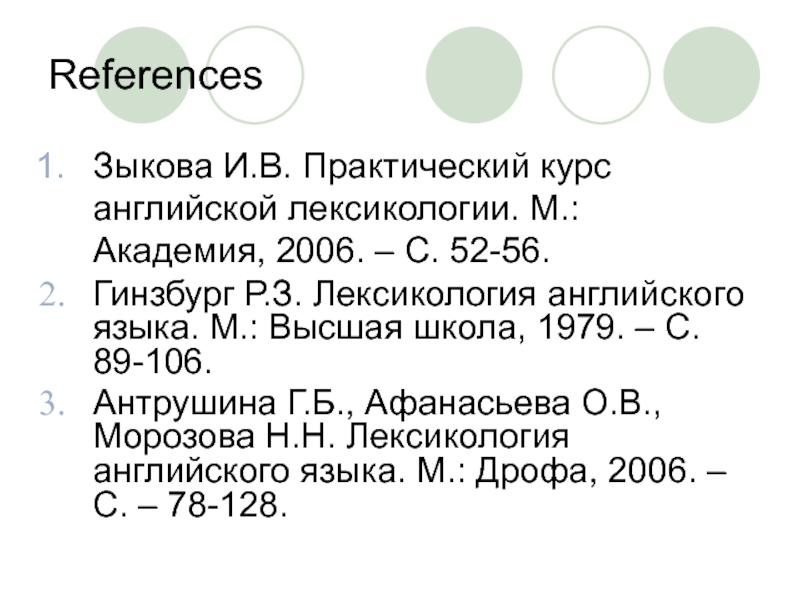Most
of the English lexicon is constituted by word which have several
morphemes. (75 % engl. Words – polymorphemic words).
In
ME most English vocabulary arises grows by making new lexemes out of
old one, by adding an affixation to previously existing forms
altering their words class and meaning by combining the existing
words (basis) to produce compounds: derivatives, derived words
(friendly
– unfriendly, teapot, bag bone).
The
contribution of word formation to the grows and development of
English lexicons is second to none, although a great deal belong to
borrowing and semantic derivation.
-
A
complex word structure – the result of different word-formation
process (illegal, discouraging, uninteresting) -
A
complex word structure may be connected with borrowing and further
identification of certain morpheme in the system of language
recipient.
Moreover
similar international structure may be the result of different word
formation process. E.g. discouraging
– discourage + ing; uninteresting – un + interesting
– morphologically(structurally) they are the same.
The
morphemic analyses and derived analyses they are differ in the aims
and basic elements.
To
eye – monomorphic (root word) It’s a derived word.A
morpheme
– the smallest meaningful language unit. Morphemes
may be classified:
-
from
the semantic point of view.
Semantically morphemes fall into two classes:-
root-morphemes
— is the lexical nucleus of a wщrd, it has an individual lexical
meaning shared by no other morpheme of the language. The
root-morpheme is isolated as the morpheme common to a set of words
making up a word-cluster, for example the morpheme teach-in
to teach,
teacher, teaching, theor- in
theory,
theorist, theoretical, etc.
-
non-root
or affixational
morphemes
include inflectional morphemes or inflections and affixational
morphemes or affixes. Roots and affixes make two distinct classes of
morphemes due to the different roles they play in word-structure.
Roots
and affixational morphemes are generally easily distinguished and the
difference between them is clearly felt as, e.g., in the words
helpless,
handy, blackness, Londoner, refill, etc.:
the root-morphemes help-,
hand-, black-, London-, -fill are
understood as the lexical centres of the words, as the basic
constituent part of a word without which the word is inconceivable.
Affixes
are classified into prefixes
and suffixes:
a prefix precedes the root-morpheme, a suffix follows it.
Affixes besides the meaning proper to root-morphemes possess the
part-of-speech meaning and a generalised lexical meaning.
-
Structurally morphemes fall into three types:
-
A
free
morpheme
is defined as one that coincides with the stem or a word-form. A
great many root-morphemes are free morphemes, for example, the
root-morpheme friend
—
of the noun friendship
is
naturally qualified as a free morpheme because it coincides with
one of the forms of the noun friend. -
A
bound
morpheme
occurs only as a constituent part of a word. Affixes are,
naturally, bound morphemes, for they always make part of a word,
e.g. the suffixes -ness,
-ship, -ise (-ize), etc.,
the prefixes un-,dis-,
de-, etc.
(e.g. readiness, comradeship, to activise; unnatural, to displease,
to decipher).
-
Many
root-morphemes also belong to the class of bound morphemes which
always occur in morphemic sequences, i.e. in combinations with ‘
roots or affixes. All unique roots and pseudo-roots are-bound
morphemes. Such are the root-morphemes theor-
in
theory,
theoretical, etc.,
barbar-in
barbarism,
barbarian, etc.,
-ceive
in
conceive, perceive,
etc.
-
Semi-bound
(semi-free)
morpheme
are morphemes that can function in a morphemic sequence both as an
affix and as a free morpheme. For example, the morpheme well
and
half
on
the one hand occur as free morphemes that coincide with the stem and
the word-form in utterances like sleep
well, half an hour,” on
the other hand they occur as bound morphemes in words like
well-known,
half-eaten, half-done.Speaking
of word-structure on the morphemic level two groups of morphemes
should be specially mentioned.
To
the
first
group
belong morphemes of Greek and Latin origin often called combining
forms,
e.g. telephone,
telegraph, phonoscope, microscope, etc.
The morphemes tele-,
graph-, scope-, micro-, phone- are
characterised by a definite lexical meaning and peculiar stylistic
reference: tele-
means
‘far’, graph-
means
‘writing’, scope
— ’seeing’, micro-
implies
smallness, phone-
means
’sound.’ Comparing words with tele-
as
their first constituent, such as telegraph,
telephone, telegram one
may conclude that tele-
is
a prefix and graph-,
phone-, gram-are
root-morphemes. On the other hand, words like phonograph,
seismograph, autograph may
create the impression that the second morpheme graph
is
a suffix and the first — a root-morpheme. These morphemes are all
bound root-morphemes of a special kind and such words belong to words
made up of bound roots. The fact that these morphemes do not possess
the part-of-speech meaning typical of affixational morphemes
evidences their status as roots.
The
second
group
embraces
morphemes occupying a kind of intermediate
position, morphemes that are changing their class membership.
According
to the number of morphemes words are classified into monomorphic
and
polymorphic.
Monomorphiс
or root-words consist of only one root-morpheme, e.g. small,
dog, make, give, etc.
Pоlуmоrphiс
words according to the number of root-morphemes are classified into
two subgroups:
-
polyradical
words, i.e. words which consist of two or more roots. Polyradical
words fall into two types:
1)
polyradical
words
which consist of two or more roots with no affixational morphemes,
e.g. book-stand,
eye-ball, lamp-shade, etc.
and
2)
words which contain
at least two
roots
and one
or more
affixational
morphemes,
e.g. safety-pin,
wedding-pie, class-consciousness, light-mindedness, pen-holder, etc.
-
Monoradical
words fall into two subtypes:
radical-suffixal
words, i.e. words that consist of one root-morpheme and one or more
suffixal morphemes, e.g. acceptable,
acceptability, blackish, etc.;
2)radical-prefixal
words, i.e. words that consist of one root-morpheme and a prefixal
morpheme, e.g. outdo,
rearrange, unbutton, etc.
and 3) prefixo-radical-suffixal,
i.e. words which consist of one root, a prefixal and suffixal
morphemes, e.g. disagreeable,
misinterpretation, etc.
Three
types of morphemic segmentability of words are distinguished:
complete,
conditional
and
defective.
Complete
segmentability is characteristic of a great many words the morphemic
structure of which is transparent enough, as their individual
morphemes clearly stand out within the word lending themselves easily
to isolation.
Conditional
morphemic segmentability characterises words whose segmentation into
the constituent morphemes is doubtful for semantic reasons. The
morphemes making up words of conditional segmentability thus differ
from morphemes making up words of complete segmentability in that the
former do not rise to the full status of morphemes for semantic
reasons and that is why a special term is applied to them in
linguistic literature: such morphemes are called pseudo-morphemes
or quasi-morphemes.
Defective
morphemic segmentability is the property of words whose component
morphemes seldom or never recur in other words. One
of
the component morphemes is a unique morpheme in the sense that it
does not, as a rule, recur in a different linguistic environment. A
unique morpheme is isolated and understood as meaningful because the
constituent morphemes display a more or less clear denotational
meaning. The morphemic analysis of words like cranberry,
gooseberry, strawberry shows
that they also possess defective morphemic segmentability: the
morphemes cran-,
goose-, straw- are
unique morphemes.
Morphemic
analyses – the
aim is to state the number and type of morphemes the word possess.
The
procedure generally employed for the purposes of segmenting words
into the constituent morphemes is the method of Immediate
and Ultimate
Constituents.
This method is based on a binary principle, i.e. each stage of the
procedure involves two components the word immediately breaks into.
At each stage these two components are referred to as the Immediate
Constituents (ICs). Each IC at the next stage of analysis is in turn
broken into two smaller meaningful elements. The analysis is
completed when we arrive at constituents incapable of further
division, i.e. morphemes. In terms of the method employed these are
referred to as the Ultimate Constituents (UCs). For example the noun
friendliness
is
first segmented into the IC friendly
recurring
in the adjectives friendly-looking
and
friendly
and
the -ness
found
in a countless number of nouns, such as happiness,
darkness, unselfishness, etc.
The IC -ness
is
at the same time a UC of the noun, as it cannot be broken into any
smaller elements possessing both sound-form and meaning. The IC
friendly
is
next broken into the ICs friend-and
-ly
recurring
in friendship,
unfriendly, etc.
on the one hand, and wifely,
brotherly, etc.,
on the other. Needless to say that the ICs friend-and
-ly
are
both UCs of the word under analysis.
The
morphemic analysis according to the IC and UC may be carried out on
the basis of two principles: the so-called root
principle
and
the
affix principle.
According to the affix
principle
the segmentation of the word into its constituent morphemes is based
on the identification of an affixational morpheme within a set of
words; for example, the identification of the suffixational morpheme
-less
leads
to the segmentation of words like useless,
hopeless, merciless, etc.,
into the suffixational morpheme -less and the root-morphemes within a
word-cluster; the identification of the root-morpheme agree- in the
words agreeable,
agreement, disagree makes
it possible to split these words into the root -agree-
and
the affixational morphemes -able,
-ment, dis-. As
a rule, the application of one of these
11.
Derivational analyses.
The
nature, type and arrangement of the ICs of the word is known as its
derivative
structure.
According to the derivative structure all words fall into two big
classes: simple,
non-derived words and complexes
or derivatives.
Simplexes
are words which derivationally cannot’ be segmented into ICs.
Derivatives
are words which depend on some other simpler lexical items that
motivate them structurally and semantically, i.e. the meaning and the
structure of the derivative is understood through the comparison with
the meaning and the structure of the source word.
The
basic elementary units of the derivative structure of words are:
derivational
bases,
derivational
affixes
and
derivational
patterns.
The relations between words with a common root but of different
derivative structure are known as derivative
relations.
The derivative and derivative relations make the subject of study at
the
derivational
level
of analysis;
it aims at establishing correlations between different types of
words, the structural and semantic patterns words are built on, the
study also enables one to understand how new words appear in the
language.
Derivational
base: is
defined as the constituent to which a rule of word-formation is
applied. Structurally derivational bases fall into three classes: 1)
bases
that coincide
with
morphological
stems
of different degrees of complexity, e.g. dutiful,
dutifully;
day-dream,
to day-dream, daydreamer.
Derivationally
the stems may be:
-
simple,
which consist of only one, semantically non motivated constituent
(pocket,
motion, retain, horrible).
b) derived
stems are semantically and structurally motivated, and are the
results of the application of word-formation rules (girl
– girlish, to weekend, to daydream)
c) compound
stems are always binary and semantically motivated (match-box,
letter-writer)
2)
bases
that coincide with
word-forms;
e.g. paper-bound,
unsmiling,
unknown.
This class of bases is confined to verbal word-forms
— the
present and the past participles.
3)
bases
that coincide with
word-grоups
of different degrees of stability, e ,g. second-rateness,
flat-waisted,
etc. This class is made of word-groups. Bases of this kind are most
active with derivational affixes in the class of adjectives and
nouns, e.g. blue-eyed,
long-fingered, old-fashioned, do-gooder, etc.
Derivational
affixes: Derivational
affixes are ICs of numerous derivatives in all parts of speech.
Derivational affixes possess two basic functions: 1)
that
of stem-building
and 2)
that
of word-building.
In most cases derivational affixes perform both
functions
simultaneously. It is true that the part-of-speech meaning is proper
in different degrees to the derivational suffixes and prefixes. It
stands out clearly in derivational suffixes but it is less evident in
prefixes; some prefixes lack it altogether. Prefixes like en-,
un-, de-,
out-,
be-,
unmistakably possess the part-of-speech meaning and function as verb
classifiers. The prefix over-evidently
lacks the part-of-speech meaning and is freely used both for verbs
and adjectives, the same may be said about non-,
pre-, post-.
Derivational
patterns: A
derivational
pattern
is a regular
meaningful arrangement, a structure that imposes rigid rules on the
order and the nature of the derivational bases and affixes that may
be brought together.
There
are two types of DPs — structural that specify base classes and
individual affixes, and structural-semantic that specify semantic
peculiarities of bases and the individual meaning of the affix. DPs
of different levels of generalisation signal: 1)
the
class of source unit that motivates the derivative and the direction
of motivation between different classes of words; 2)
the
part of speech of the derivative; 3)
the
lexical sets and semantic features of derivatives.
Соседние файлы в предмете [НЕСОРТИРОВАННОЕ]
- #
- #
- #
- #
- #
- #
- #
- #
- #
- #
- #
WORD STRUCTURE IN MODERN ENGLISH
I. The morphological structure of a word. Morphemes. Types of morphemes. Allomorphs.
II. Structural types of words.
III. Principles of morphemic analysis.
IV. Derivational level of analysis. Stems. Types of stems. Derivational types of words.
I. The morphological structure of a word. Morphemes. Types of Morphemes. Allomorphs.
There are two levels of approach to the study of word- structure: the level of morphemic analysis and the level of derivational or word-formation analysis.
Word is the principal and basic unit of the language system, the largest on the morphologic and the smallest on the syntactic plane of linguistic analysis.
It has been universally acknowledged that a great many words have a composite nature and are made up of morphemes, the basic units on the morphemic level, which are defined as the smallest indivisible two-facet language units.
The term morpheme is derived from Greek morphe “form ”+ -eme. The Greek suffix –eme has been adopted by linguistic to denote the smallest unit or the minimum distinctive feature.
The morpheme is the smallest meaningful unit of form. A form in these cases a recurring discrete unit of speech. Morphemes occur in speech only as constituent parts of words, not independently, although a word may consist of single morpheme. Even a cursory examination of the morphemic structure of English words reveals that they are composed of morphemes of different types: root-morphemes and affixational morphemes. Words that consist of a root and an affix are called derived words or derivatives and are produced by the process of word building known as affixation (or derivation).
The root-morpheme is the lexical nucleus of the word; it has a very general and abstract lexical meaning common to a set of semantically related words constituting one word-cluster, e.g. (to) teach, teacher, teaching. Besides the lexical meaning root-morphemes possess all other types of meaning proper to morphemes except the part-of-speech meaning which is not found in roots.
Affixational morphemes include inflectional affixes or inflections and derivational affixes. Inflections carry only grammatical meaning and are thus relevant only for the formation of word-forms. Derivational affixes are relevant for building various types of words. They are lexically always dependent on the root which they modify. They possess the same types of meaning as found in roots, but unlike root-morphemes most of them have the part-of-speech meaning which makes them structurally the important part of the word as they condition the lexico-grammatical class the word belongs to. Due to this component of their meaning the derivational affixes are classified into affixes building different parts of speech: nouns, verbs, adjectives or adverbs.
Roots and derivational affixes are generally easily distinguished and the difference between them is clearly felt as, e.g., in the words helpless, handy, blackness, Londoner, refill, etc.: the root-morphemes help-, hand-, black-, London-, fill-, are understood as the lexical centers of the words, and –less, -y, -ness, -er, re- are felt as morphemes dependent on these roots.
Distinction is also made of free and bound morphemes.
Free morphemes coincide with word-forms of independently functioning words. It is obvious that free morphemes can be found only among roots, so the morpheme boy- in the word boy is a free morpheme; in the word undesirable there is only one free morpheme desire-; the word pen-holder has two free morphemes pen- and hold-. It follows that bound morphemes are those that do not coincide with separate word- forms, consequently all derivational morphemes, such as –ness, -able, -er are bound. Root-morphemes may be both free and bound. The morphemes theor- in the words theory, theoretical, or horr- in the words horror, horrible, horrify; Angl- in Anglo-Saxon; Afr- in Afro-Asian are all bound roots as there are no identical word-forms.
It should also be noted that morphemes may have different phonemic shapes. In the word-cluster please , pleasing , pleasure , pleasant the phonemic shapes of the word stand in complementary distribution or in alternation with each other. All the representations of the given morpheme, that manifest alternation are called allomorphs/or morphemic variants/ of that morpheme.
The combining form allo- from Greek allos “other” is used in linguistic terminology to denote elements of a group whose members together consistute a structural unit of the language (allophones, allomorphs). Thus, for example, -ion/ -tion/ -sion/ -ation are the positional variants of the same suffix, they do not differ in meaning or function but show a slight difference in sound form depending on the final phoneme of the preceding stem. They are considered as variants of one and the same morpheme and called its allomorphs.
Allomorph is defined as a positional variant of a morpheme occurring in a specific environment and so characterized by complementary description.
Complementary distribution is said to take place, when two linguistic variants cannot appear in the same environment.
Different morphemes are characterized by contrastive distribution, i.e. if they occur in the same environment they signal different meanings. The suffixes –able and –ed, for instance, are different morphemes, not allomorphs, because adjectives in –able mean “ capable of beings”.
Allomorphs will also occur among prefixes. Their form then depends on the initials of the stem with which they will assimilate.
Two or more sound forms of a stem existing under conditions of complementary distribution may also be regarded as allomorphs, as, for instance, in long a: length n.
II. Structural types of words.
The morphological analysis of word- structure on the morphemic level aims at splitting the word into its constituent morphemes – the basic units at this level of analysis – and at determining their number and types. The four types (root words, derived words, compound, shortenings) represent the main structural types of Modern English words, and conversion, derivation and composition the most productive ways of word building.
According to the number of morphemes words can be classified into monomorphic and polymorphic. Monomorphic or root-words consist of only one root-morpheme, e.g. small, dog, make, give, etc. All polymorphic word fall into two subgroups: derived words and compound words – according to the number of root-morphemes they have. Derived words are composed of one root-morpheme and one or more derivational morphemes, e.g. acceptable, outdo, disagreeable, etc. Compound words are those which contain at least two root-morphemes, the number of derivational morphemes being insignificant. There can be both root- and derivational morphemes in compounds as in pen-holder, light-mindedness, or only root-morphemes as in lamp-shade, eye-ball, etc.
These structural types are not of equal importance. The clue to the correct understanding of their comparative value lies in a careful consideration of: 1)the importance of each type in the existing wordstock, and 2) their frequency value in actual speech. Frequency is by far the most important factor. According to the available word counts made in different parts of speech, we find that derived words numerically constitute the largest class of words in the existing wordstock; derived nouns comprise approximately 67% of the total number, adjectives about 86%, whereas compound nouns make about 15% and adjectives about 4%. Root words come to 18% in nouns, i.e. a trifle more than the number of compound words; adjectives root words come to approximately 12%.
But we cannot fail to perceive that root-words occupy a predominant place. In English, according to the recent frequency counts, about 60% of the total number of nouns and 62% of the total number of adjectives in current use are root-words. Of the total number of adjectives and nouns, derived words comprise about 38% and 37% respectively while compound words comprise an insignificant 2% in nouns and 0.2% in adjectives. Thus it is the root-words that constitute the foundation and the backbone of the vocabulary and that are of paramount importance in speech. It should also be mentioned that root words are characterized by a high degree of collocability and a complex variety of meanings in contrast with words of other structural types whose semantic structures are much poorer. Root- words also serve as parent forms for all types of derived and compound words.
III. Principles of morphemic analysis.
In most cases the morphemic structure of words is transparent enough and individual morphemes clearly stand out within the word. The segmentation of words is generally carried out according to the method of Immediate and Ultimate Constituents. This method is based on the binary principle, i.e. each stage of the procedure involves two components the word immediately breaks into. At each stage these two components are referred to as the Immediate Constituents. Each Immediate Constituent at the next stage of analysis is in turn broken into smaller meaningful elements. The analysis is completed when we arrive at constituents incapable of further division, i.e. morphemes. These are referred to Ultimate Constituents.
A synchronic morphological analysis is most effectively accomplished by the procedure known as the analysis into Immediate Constituents. ICs are the two meaningful parts forming a large linguistic unity.
The method is based on the fact that a word characterized by morphological divisibility is involved in certain structural correlations. To sum up: as we break the word we obtain at any level only ICs one of which is the stem of the given word. All the time the analysis is based on the patterns characteristic of the English vocabulary. As a pattern showing the interdependence of all the constituents segregated at various stages, we obtain the following formula:
un+ { [ ( gent- + -le ) + -man ] + -ly}
Breaking a word into its Immediate Constituents we observe in each cut the structural order of the constituents.
A diagram presenting the four cuts described looks as follows:
1. un- / gentlemanly
2. un- / gentleman / — ly
3. un- / gentle / — man / — ly
4. un- / gentl / — e / — man / — ly
A similar analysis on the word-formation level showing not only the morphemic constituents of the word but also the structural pattern on which it is built.
The analysis of word-structure at the morphemic level must proceed to the stage of Ultimate Constituents. For example, the noun friendliness is first segmented into the ICs: [frendlı-] recurring in the adjectives friendly-looking and friendly and [-nıs] found in a countless number of nouns, such as unhappiness, blackness, sameness, etc. the IC [-nıs] is at the same time an UC of the word, as it cannot be broken into any smaller elements possessing both sound-form and meaning. Any further division of –ness would give individual speech-sounds which denote nothing by themselves. The IC [frendlı-] is next broken into the ICs [-lı] and [frend-] which are both UCs of the word.
Morphemic analysis under the method of Ultimate Constituents may be carried out on the basis of two principles: the so-called root-principle and affix principle.
According to the affix principle the splitting of the word into its constituent morphemes is based on the identification of the affix within a set of words, e.g. the identification of the suffix –er leads to the segmentation of words singer, teacher, swimmer into the derivational morpheme – er and the roots teach- , sing-, drive-.
According to the root-principle, the segmentation of the word is based on the identification of the root-morpheme in a word-cluster, for example the identification of the root-morpheme agree- in the words agreeable, agreement, disagree.
As a rule, the application of these principles is sufficient for the morphemic segmentation of words.
However, the morphemic structure of words in a number of cases defies such analysis, as it is not always so transparent and simple as in the cases mentioned above. Sometimes not only the segmentation of words into morphemes, but the recognition of certain sound-clusters as morphemes become doubtful which naturally affects the classification of words. In words like retain, detain, contain or receive, deceive, conceive, perceive the sound-clusters [rı-], [dı-] seem to be singled quite easily, on the other hand, they undoubtedly have nothing in common with the phonetically identical prefixes re-, de- as found in words re-write, re-organize, de-organize, de-code. Moreover, neither the sound-cluster [rı-] or [dı-], nor the [-teın] or [-sı:v] possess any lexical or functional meaning of their own. Yet, these sound-clusters are felt as having a certain meaning because [rı-] distinguishes retain from detain and [-teın] distinguishes retain from receive.
It follows that all these sound-clusters have a differential and a certain distributional meaning as their order arrangement point to the affixal status of re-, de-, con-, per- and makes one understand —tain and –ceive as roots. The differential and distributional meanings seem to give sufficient ground to recognize these sound-clusters as morphemes, but as they lack lexical meaning of their own, they are set apart from all other types of morphemes and are known in linguistic literature as pseudo- morphemes. Pseudo- morphemes of the same kind are also encountered in words like rusty-fusty.
IV. Derivational level of analysis. Stems. Types of Stems. Derivational types of word.
The morphemic analysis of words only defines the constituent morphemes, determining their types and their meaning but does not reveal the hierarchy of the morphemes comprising the word. Words are no mere sum totals of morpheme, the latter reveal a definite, sometimes very complex interrelation. Morphemes are arranged according to certain rules, the arrangement differing in various types of words and particular groups within the same types. The pattern of morpheme arrangement underlies the classification of words into different types and enables one to understand how new words appear in the language. These relations within the word and the interrelations between different types and classes of words are known as derivative or word- formation relations.
The analysis of derivative relations aims at establishing a correlation between different types and the structural patterns words are built on. The basic unit at the derivational level is the stem.
The stem is defined as that part of the word which remains unchanged throughout its paradigm, thus the stem which appears in the paradigm (to) ask ( ), asks, asked, asking is ask-; thestem of the word singer ( ), singer’s, singers, singers’ is singer-. It is the stem of the word that takes the inflections which shape the word grammatically as one or another part of speech.
The structure of stems should be described in terms of IC’s analysis, which at this level aims at establishing the patterns of typical derivative relations within the stem and the derivative correlation between stems of different types.
There are three types of stems: simple, derived and compound.
Simple stems are semantically non-motivated and do not constitute a pattern on analogy with which new stems may be modeled. Simple stems are generally monomorphic and phonetically identical with the root morpheme. The derivational structure of stems does not always coincide with the result of morphemic analysis. Comparison proves that not all morphemes relevant at the morphemic level are relevant at the derivational level of analysis. It follows that bound morphemes and all types of pseudo- morphemes are irrelevant to the derivational structure of stems as they do not meet requirements of double opposition and derivative interrelations. So the stem of such words as retain, receive, horrible, pocket, motion, etc. should be regarded as simple, non- motivated stems.
Derived stems are built on stems of various structures though which they are motivated, i.e. derived stems are understood on the basis of the derivative relations between their IC’s and the correlated stems. The derived stems are mostly polymorphic in which case the segmentation results only in one IC that is itself a stem, the other IC being necessarily a derivational affix.
Derived stems are not necessarily polymorphic.
Compound stems are made up of two IC’s, both of which are themselves stems, for example match-box, driving-suit, pen-holder, etc. It is built by joining of two stems, one of which is simple, the other derived.
In more complex cases the result of the analysis at the two levels sometimes seems even to contracted one another.
The derivational types of words are classified according to the structure of their stems into simple, derived and compound words.
Derived words are those composed of one root- morpheme and one or more derivational morpheme.
Compound words contain at least two root- morphemes, the number of derivational morphemes being insignificant.
Derivational compound is a word formed by a simultaneous process of composition and derivational.
Compound words proper are formed by joining together stems of word already available in the language.
Теги:
Word structure in modern english
Реферат
Английский
Просмотров: 27758
Найти в Wikkipedia статьи с фразой: Word structure in modern english
1. WORD-STRUCTURE Morphemic Structure of Words
Lecture 8
2. 1. Word-Structure and Morphemes
Morphe – ‘form’ + -eme. The Greek suffix – eme
has been adopted by linguists to denote the
smallest unit (phoneme, sememe, lexeme)
Word-structure is internal organization of
words.
The morpheme is the smallest indivisible twofacet language unit.
3. MORPHEMES
Morphemes cannot be segmented into
smaller units without losing their
constitutive essence (two-facetedness) –
association of a certain meaning with a
certain sound-pattern.
Morphemes occur in speech only as
constituent parts of words but not
independently.
4. SEGMENTATION OF WORDS INTO MORPHEMES
Boiler = boil- + er;
Driller = drill- + er ;
recurrence of the morpheme -er in these
and other similar words and of the
morphemes boil- and drill- in
to boil, a boil, boiling and
to drill, a drill, drilling, a drill-press, etc.
5. SEGMENTATION OF WORDS INTO MORPHEMES
flower-pot = flower- + -pot;
shoe-lace = shoe- + -lace;
Like a word a morpheme is a two-facet
language unit, an association of a certain
meaning with a certain sound-pattern.
Unlike a word a morpheme is not an
autonomous unit and can occur in speech
only as a constituent part of the word.
Lace [l], [ei] ,[s] — without meaning.
6. Word-cluster
please
[pli:z]
pleasing
[pli:z]
pleasure
[pleʒ]
pleasant
[plez]
All the representations of the given
morpheme that manifest alteration are
called allomorphs of that morpheme or
morpheme variants.
Thus, [pli:z], [plez] and [рlеʒ] are
allomorphs of оnе and the same
morpheme.
7. The root-morphemes in the word-clusters
Duke [dju:k], ducal [‘dju:kl],
duchess [‘d˄tʃiƨ], duchy [‘d˄tʃi]
or
Poor [puə] , poverty [‘povəti] are the allomorphs of one morpheme
8. 2.1. Semantic Classification of Morphemes
1. Root-morphemes (radicals) — the
lexical nucleus of words, which has an
individual lexical meaning shared by no other
morpheme of the language:
Helpless, handy, rewrite, hopeful, disorder
Help- hand- -write hope- -order
The root-morpheme is isolated as the morpheme
common to a set of words making up a wordcluster:
work- in to work, worker, working or
theor- in theory, theorist, theoretical, etc.
9. Non-root morphemes
2. Non-root morphemes include inflectional
morphemes (inflections) and affixational
morphemes (affixes). Inflections carry only
grammatical meaning.
Lexicology is concerned only with
affixational morphemes.
A prefix: understand – mis-understand, correct
– in-correct).
A suffix: (-en, -y, -less in heart-en heart-y, heartless).
10. 2.2. Structural Classification of Morphemes
1. A free morpheme — one that coincides with the
stem or a word-form. Many root-morphemes are
free morphemes, for example, use − of the noun
useless is a free morpheme because it coincides
with one of the forms of the noun use.
2. A bound morpheme — a morpheme that must be
attached to another element. It occurs only as a
constituent part of a word. Affixes are bound
morphemes for they always make part of a word,
for example:-ness, -ship in the words kind-ness,
friend-ship; un-, dis- in the words un-tidy, dis-like.
11.
All unique roots and pseudo-roots arebound morphemes.
Such are the root-morphemes theor- in
theory, theoretical, etc.,
barbar-in barbarism, barbarian, etc.,
-ceive in conceive, perceive, etc.
12.
3. Semi-bound (semi-free) morphemes
-morphemes that can function in a
morphemic sequence both as an affix
and as a free morpheme: the morpheme
well and half can occur as free
morphemes: sing well, half a month.
They can also occur as bound
morphemes in words like well-known,
half-eaten, half-done.
13. The relationship between the two classifications of morphemes
14. Word-structure on the morphemic level:
1st Group — Combining forms are
morphemes borrowed namely from Greek
or Latin in which they exist as free forms.
They are considered to be bound roots:
tele-phone consists of two bound roots.
Phonoscope = ‘sound’ + ‘seeing’;
Microscope = ‘smallness’ + ‘seeing’;
Telegraph = ‘far’ + ‘writing’;
15. The 2nd Group embraces morphemes occupying a kind of intermediate position, morphemes that are changing their class membership.
Root morpheme man – in postman,
fisherman, gentleman, etc. in comparison
with man-made, man-servant.
-man = -er; in cabman, chairman, tradesman
Not a male adult But agent!
* She is an Englishman
*All women are tradesmen.
16. 3. TYPES OF MEANING IN MORPHEMES
In morphemes can be singled out different
types of meaning depending on the semantic
class they belong to.
1. Root-morphemes have lexical, differential and
distributional types of meaning.
2. Affixational morphemes have lexical, part ofspeech, differential and distributional types of
meaning.
3. Both root-morphemes and affixational
morphemes are devoid of grammatical
meaning.
17. 3.1. LEXICAL MEANING
1. Root-morphemes have an individual
lexical meaning shared by no other
morphemes in the language: light, deaf,
deep, etc.
2. Affixational morphemes have a more
generalizing character of lexical
meaning: the suffix –en carries the
meaning “the change of a quality”, e.g.
to lighten – to become lighter, to deafen
– to make somebody deaf.
18. Morphemes may be also analyzed into denotational and connotational components:
1. The connotational component of meaning
may be found in affixational morphemes:
-ette (kitchenette); -ie (dearie, girlie); -ling
(duckling) bear a heavy emotive charge.
19.
1. The affixational morphemes with the
same denotational meaning sometimes
differ only in connotation: the
morphemes –ly, –like, -ish in the words
womanly, womanlike, womanish have
the same denotational meaning of
similarity but differ in the connotational
component (женственный – женский –
бабий).
20.
Stylistic reference may be found in
morphemes of different types: the
affixational morphemes –
-ine (chlorine), -oid (rhomboid)
are bookish.
21. 3.2. DIFFERENTIAL MEANING
Differential meaning is the semantic
component that serves to distinguish one word
from all others containing identical
morphemes. In words consisting of two or
more morphemes, one of the constituent
morphemes always has differential meaning:
in the word forehead the morpheme – head
serves to distinguish the word from other
words containing the morpheme fore-:
forefoot, forepart, foreground.
22. 3.2. DISTRIBUTIONAL MEANING
Distributional meaning is the meaning of the
order and arrangement of morphemes making up
the word.
It is found in all words containing more than one
morpheme: the word teacher is composed of two
morphemes teach- and –er both of which
possess the denotational meaning ‘to help
students to learn something’ and ‘the doer of the
action’.
A different arrangement of the same morphemes
*erteach would make the word meaningless.
23. 3.4. PART-OF-SPEECH MEANING
Part-of-speech meaning is the indicative of the
part of speech to which a derivational word
belongs: the affixational morpheme – ness
(darkness) is used to form nouns, while the
affixational morpheme –less (careless) forms
adjectives.
Sometimes the part-of-speech meaning of
morphemes predominates: the morpheme –ice
in the word justice serves principally to transfer
the part-of-speech meaning of the morpheme
just- into another class and namely that of the
noun.
24. 4. MORPHEMIC TYPES OF WORDS
I.
According to the number of morphemes
words are classified into monomorphic
(root-words) and polymorphic words.
Monomorphic or root-words consist of
only one root-morpheme: small, dog,
make, put, doll, pen, ect.
25.
II.
Polymorphic words according to the
number of root-morphemes are classified
into:
1. Monoradical words (having one-root
morpheme) fall into three subtypes:
a) radical-suffixal words, i.e. words consisting
of one root-morpheme and two or more
suffixal morphemes, for example, respectable,
respectability;
b) radical-prefixal words, i.e. words consisting
of one root-morpheme and a prefixal
morpheme, for example, overcome, unbutton;
c) prefixo-radical-suffixal words, i.e. words
which consist of one root, prefixal and suffixal
morphemes (e.g. unforgettable,
misinterpretation).
26.
2. Polyradical words (having words
consisting of two or more roots) fall into
two subtypes:
a) polyradical words which consist of two or
more roots with no affixational morpheme, for
example, pen-friend, copybook;
b) polyradical words which contain at least two
roots and one or more affixational morpheme,
for instance, safety-pin, light-mindedness,
pen-holder.
27. 5. TYPES OF WORD-SEGMENTABILITY
Word-segmentability is the division of
words into morphemes.
Three types of morphemic segmentability
of words are distinguished:
1.complete,
2.conditional,
3.defective.
28. 5.1. COMPLETE SEGMENTABILITY
Complete segmentability
is characteristic of words, the morphemic
structure of which is transparent enough,
as their individual morphemes clearly
stand out within the word and can be
easily isolated.
29. The morphemes making up words of complete segmentability are called morpheme proper or full morphemes
The transparent morphemic structure of
the segmentable words careless,
stressful is conditioned by the fact
that their constituent morpheme recur
with the same meaning in other
words: thoughtful, powerful.
30. 5.2. CONDITIONAL SEGMENTSBILITY
Conditional segmentability
characterizes words whose
segmentation into the constituent
morphemes is doubtful for semantic
reasons.
In the words retain, detain or deceive
the sound-cluster – [ri-], [di-] seem to
be singled out easily due to their
recurrence in a number of words (cf.
rewrite, reorganize, decode,
deorganize).
31.
Neither [ri-], [di-] nor [-tain], [si:v] possess
any lexical or part-of-speech meaning of
their own.
They have differential and distributional
meanings: the [ri-] distinguishes retain
from detain and the [-tein] distinguishes
retain from receive, whereas their order
and arrangement point to the status of the
re-, de- as different from that of the –tain
and –ceive within the structure of the
words.
32.
The morphemes making up words of
conditional segmentability do not rise to
the status of full morphemes for
semantic reason and that is why are
called pseudo-morphemes or
quasi-morphemes.
33. 5.3. DEFECTIVE SEGMENTABILITY
Defective segmentability is the property of
words whose component morphemes seldom
or never recur in other words.
One of the component morphemes of these
words is a unique morpheme, which is
isolated and understood as meaningful
because the constituent morphemes display
a more or less clear denotational meaning.
In streamlet, ringlet, leaflet the morpheme –
let has diminutive meaning.
34.
In the word hamlet the morpheme -let has
the meaning of diminutiveness. This
morpheme occurs in the words ringlet,
leaflet, streamlet.
The sound-cluster [hæm-] does not recur in
any other English word.
The morpheme ham- carries a differential
and distributional meaning as it
distinguishes hamlet from streamlet, ringlet.
35. comparison with words
locket, lionet, cellaret, etc. leads
one to the isolation of the morpheme
-et having a diminutive meaning, the
more so that the morphemes lock-,
lion-, cellar-, etc. recur in other
words: (cf. lock, locky; lion, lioness;
cellar, cellarage).
36.
The isolation of the morpheme -et leaves
in the word pocket the sound-cluster [роk]
that does not occur in any other word of
Modern English.
The morpheme [роk] clearly carries a
differential and distributional meaning as it
distinguishes pocket from the words
mentioned above and thus must be
qualified as a unique morpheme.
37. The morphemic analysis of words like
cranberry, gooseberry, strawberry
shows that they also possess
defective morphemic segmentability:
the morphemes cran-, goose-, straware unique morphemes.
38. on the level of morphemic analysis
the linguist has to operate with two types of
elementary units, namely full morphemes
and pseudo-(quasi-)morphemes.
A considerable percentage of words of
conditional and defective segmentability
signals a relatively complex character of the
morphological system of the language,
reveals the existence of various
heterogeneous layers in its vocabulary.
39. 7. PROCEDURE OF MORPHEMIC ANALYSIS
The procedure of segmenting words into the
constituent morphemes is known as the
method of Immediate and Ultimate
Constituents (any of two meaningful
parts forming a larger linguistic unit. L.
Bloomfield).
It is based on a binary principle, i.e. each
stage of the procedure involves two
components the word immediately breaks
into.
40.
At each stage these two components are
referred to as the Immediate
constituents (ICs). Each IC at the next
stage of analysis is broken into smaller
meaningful elements.
The analysis is completed when
constituents are incapable of further
division, i.e. morphemes.
These morphemes are referred to as the
Ultimate Constituents (UCs).
41.
The noun friendliness is first segmented into the
ICs:
1. friendly- (recurring in the adjectives friendly and
friendly-looking).
2. –ness (found in a countless number of nouns):
happiness, darkness.
The IC –ness is at the same time an UC of the
noun, as it cannot be broken into any smaller
elements possessing both sound-form and
meaning.
The IC friendly- is next broken into the ICs
1) friend- (recurring in friendship, unfriendly) and
2) –ly (recurring in wifely, brotherly).
The ICs friend- and –ly are both UCs of the word
under analysis.
42. The procedure of segmenting a word into its Ultimate Constituent morphemes
43. 8. PRINCIPLES OF WORD-SEGMENTATION
According to the affix principle the
segmentation of the word into its
constituent morphemes is based on the
identification of an affixational
morpheme within a set of words, for
example, the identification of the
morphemes –less leads to the
segmentation of words like thoughtless,
careless, merciless into the suffixational
morpheme –less and the rootmorphemes thought-, care-, merciwithin a word-cluster.
44.
According to the root principle the
identification of the root-morpheme agreein the words agreeable, agreement,
disagree makes it possible to split these
words into the root agree- and the
affixational morphemes -able, -ment, dis-.
45. Summary and Conclusions:
1. There are two levels of approach to the
study of word-structure: the level of
morphemic analysis and the level of
derivational or word-formation analysis.
2. The basic unit of the morphemic level is
the morpheme defined as the smallest
indivisible two-facet language unit.
46. Summary and Conclusions:
3. Three types of morphemic segmentability of
words are distinguished in linguistic
literature: complete, conditional and
defective. Words of conditional and defective
segmentability are made up of full
morphemes and pseudo (quasi) morphemes.
The latter do not rise to the status of full
morphemes either for semantic reasons or
because of their unique distribution.
47. Summary and Conclusions:
4. Semantically morphemes fall into rootmorphemes and affixational morphemes
(prefixes and suffixes); structurally into free,
bound and semi-free (semi-bound) morphemes.
5. The structural types of words at the morphemic
level are described in terms of the number and
type of their ICs as monomorphic and
polymorphic words.
48. References
1. Зыкова И.В. Практический курс
английской лексикологии. М.:
Академия, 2006. – С. 52-56.
2. Гинзбург Р.З. Лексикология английского
языка. М.: Высшая школа, 1979. – С.
89-106.
3. Антрушина Г.Б., Афанасьева О.В.,
Морозова Н.Н. Лексикология
английского языка. М.: Дрофа, 2006. –
С. – 78-128.
Presentation on theme: «WORD-STRUCTURE Morphemic Structure of Words»— Presentation transcript:
1
WORD-STRUCTURE Morphemic Structure of Words
Lecture 9
2
1. Word-Structure and Morphemes
Word-structure is internal organization of words. The morpheme is the smallest indivisible two-facet language unit. Morphemes occur in speech only as constituent parts of words but not independently. Word-cluster please pleasing pleasure pleasant [pli:z] [pli:z] [pleʒ] [plez] All the representations of the given morpheme that manifest alteration are called allomorphs of that morpheme or morpheme variants. Thus, [pli:z], [plez] and [рlеʒ] are allomorphs of оnе and the same morpheme.
3
2.1. Semantic Classification of Morphemes
Root-morphemes (radicals) — the lexical nucleus of words, which has an individual lexical meaning shared by no other morpheme of the language: rewrite, hopeful, disorder write hope order The root-morpheme is isolated as the morpheme common to a set of words making up a word-cluster: work- in to work, worker, working or theor- in theory, theorist, theoretical, etc. Non-root morphemes include inflectional morphemes (inflections) and affixational morphemes (affixes). Inflections carry only grammatical meaning. Lexicology is concerned only with affixational morphemes.
4
2.2. Structural Classification of Morphemes
A free morpheme — one that coincides with the stem or a word-form. Many root-morphemes are free morphemes, for example, use − of the noun useless is a free morpheme because it coincides with one of the forms of the noun use. A bound morpheme — a morpheme that must be attached to another element. It occurs only as a constituent part of a word. Affixes are bound morphemes for they always make part of a word, for example:-ness, -ship in the words kind-ness, friend-ship; un-, dis- in the words un-tidy, dis-like.
5
Combining forms are morphemes borrowed namely from Greek or Latin in which they exist as free forms. They are considered to be bound roots: tele-phone consists of two bound roots. Semi-bound (semi-free) morphemes -morphemes that can function in a morphemic sequence both as an affix and as a free morpheme: the morpheme well and half can occur as free morphemes: sing well, half a month. They can also occur as bound morphemes in words like well-known, half-eaten, half-done.
6
The relationship between the two classifications of morphemes
7
3. TYPES OF MEANING IN MORPHEMES
In morphemes can be singled out different types of meaning depending on the semantic class they belong to. Root-morphemes have lexical, differential and distributional types of meaning. Affixational morphemes have lexical, part of-speech, differential and distributional types of meaning. Both root-morphemes and affixational morphemes are devoid of grammatical meaning.
8
3.1. LEXICAL MEANING Root-morphemes have an individual lexical meaning shared by no other morphemes in the language: light, deaf, deep, etc. Affixational morphemes have a more generalizing character of lexical meaning: the suffix –en carries the meaning “the change of a quality”, e.g. to lighten – to become lighter, to deafen – to make somebody deaf.
9
Morphemes may be also analyzed into denotational and connotational components:
The connotational component of meaning may be found in affixational morphemes: -ette (kitchenette); -ie (dearie, girlie); -ling (duckling) bear a heavy emotive charge. The affixational morphemes with the same denotational meaning sometimes differ only in connotation: the morphemes –ly, –like, -ish in the words womanly, womanlike, womanish have the same denotational meaning of similarity but differ in the connotational component (женственный – женский – бабий). Stylistic reference may be found in morphemes of different types: the affixational morphemes – ine (chlorine), -oid (rhomboid) are bookish.
10
3.2. DIFFERENTIAL MEANING Differential meaning is the semantic component that serves to distinguish one word from all others containing identical morphemes. In words consisting of two or more morphemes, one of the constituent morphemes always has differential meaning: in the word forehead the morpheme – head serves to distinguish the word from other words containing the morpheme fore-: forefoot, forepart, foreground.
11
3.2. DISTRIBUTIONAL MEANING
Distributional meaning is the meaning of the order and arrangement of morphemes making up the word. It is found in all words containing more than one morpheme: the word teacher is composed of two morphemes teach- and –er both of which possess the denotational meaning ‘to help students to learn something’ and ‘the doer of the action’. A different arrangement of the same morphemes *echtaing would make the word meaningless.
12
3.4. PART-OF-SPEECH MEANING
Part-of-speech meaning is the indicative of the part of speech to which a derivational word belongs: the affixational morpheme – ness (darkness) is used to form nouns, while the affixational morpheme –less (careless) forms adjectives. Sometimes the part-of-speech meaning of morphemes predominates: the morpheme –ice in the word justice serves principally to transfer the part-of-speech meaning of the morpheme just- into another class and namely that of the noun.
13
4. MORPHEMIC TYPES OF WORDS
According to the number of morphemes words are classified into monomorphic (root-words) and polymorphic words. Monomorphic or root-words consist of only one root-morpheme: small, dog, make, ect.
14
Polymorphic words according to the number of root-morphemes are classified into:
Monoradical words (having one-root morpheme) fall into three subtypes: radical-suffixal words, i.e. words consisting of one root-morpheme and two or more suffixal morphemes, for example, respectable, respectability; radical-prefixal words, i.e. words consisting of one root-morpheme and a prefixal morpheme, for example, overcome, unbutton; prefixo-radical-suffixal words, i.e. words which consist of one root, prefixal and suffixal morphemes (e.g. unforgettable, misinterpretation).
15
Polyradical words (having words consisting of two or more roots) fall into two subtypes:
polyradical words which consist of two or more roots with no affixational morpheme, for example, pen-friend, copybook; polyradical words which contain at least two roots and one or more affixational morpheme, for instance, safety-pin, light-mindedness, pen-holder.
16
5. TYPES OF WORD-SEGMENTABILITY
Word-segmentability is the division of words into morphemes. Three types of morphemic segmentability of words are distinguished: complete, conditional, defective.
17
5.1. COMPLETE SEGMENTABILITY
Complete segmentability is characteristic of words, the morphemic structure of which is transparent enough, as their individual morphemes clearly stand out within the word and can be easily isolated. The morphemes making up words of complete segmentability are called morpheme proper or full morphemes. The transparent morphemic structure of the segmentable words careless, stressful is conditioned by the fact that their constituent morpheme recur with the same meaning in other words: a jump, to jump, use, to use and homeless, powerless.
18
5.2. CONDITIONAL SEGMENTSBILITY
Conditional segmentability characterizes words whose segmentation into the constituent morphemes is doubtful for semantic reasons. In the words retain, detain or deceive the sound-cluster – [ri-], [di-] seem to be singled out easily due to their recurrence in a number of words (cf. rewrite, reorganize, decode, deorganize).
19
Neither [ri-], [di-] nor [-tain], [si:v] possess any lexical or part-of-speech meaning of their own.
They have differential and distributional meanings: the [ri-] distinguishes retain from detain and the [-tein] distinguishes retain from receive, whereas their order and arrangement point to the status of the re-, de- as different from that of the –tain and –ceive within the structure of the words. The morphemes making up words of conditional segmentability do not rise to the status of full morphemes for semantic reason and that is why are called pseudo-morphemes or quasi-morphemes.
20
5.3. DEFECTIVE SEGMENTABILITY
Defective segmentability is the property of words whose component morphemes seldom or never recur in other words. One of the component morphemes of these words is a unique morpheme, which is isolated and understood as meaningful because the constituent morphemes display a more or less clear denotational meaning. In the word hamlet the morpheme -let has the meaning of diminutiveness. This morpheme occurs in the words ringlet, leaflet, streamlet. The sound-cluster [hæm-] does not recur in any other English word. The morpheme ham- carries a differential and distributional meaning as it distinguishes hamlet from streamlet, ringlet.
21
6. PROCEDURE OF MORPHEMIC ANALYSIS
The procedure of segmenting words into the constituent morphemes is known as the method of Immediate and Ultimate Constituents (any of two meaningful parts forming a larger linguistic unit. L. Bloomfield). It is based on a binary principle, i.e. each stage of the procedure involves two components the word immediately breaks into. At each stage these two components are referred to as the Immediate constituents (ICs). Each IC at the next stage of analysis is broken into smaller meaningful elements. The analysis is completed when constituents are incapable of further division, i.e. morphemes. These morphemes are referred to as the Ultimate Constituents (UCs).
22
The noun friendliness is first segmented into the ICs:
friendly- (recurring in the adjectives friendly and friendly-looking). –ness (found in a countless number of nouns): happiness, darkness. The IC –ness is at the same time an UC of the noun, as it cannot be broken into any smaller elements possessing both sound-form and meaning. The IC friendly- is next broken into the ICs friend- (recurring in friendship, unfriendly) and –ly (recurring in wifely, brotherly). The ICs friend- and –ly are both UCs of the word under analysis.
23
7. PRINCIPLES OF WORD-SEGMENTATION
According to the affix principle the segmentation of the word into its constituent morphemes is based on the identification of an affixational morpheme within a set of words, for example, the identification of the morphemes –less leads to the segmentation of words like thoughtless, careless, merciless into the suffixational morpheme –less and the root-morphemes thought-, care-, merci- within a word-cluster.
24
According to the root principle the identification of the root-morpheme agree- in the words agreeable, agreement, disagree makes it possible to split these words into the root agree- and the affixational morphemes -able, -ment, dis-.
Слайд 1WORD-STRUCTURE
Morphemic Structure of Words
Lecture 8
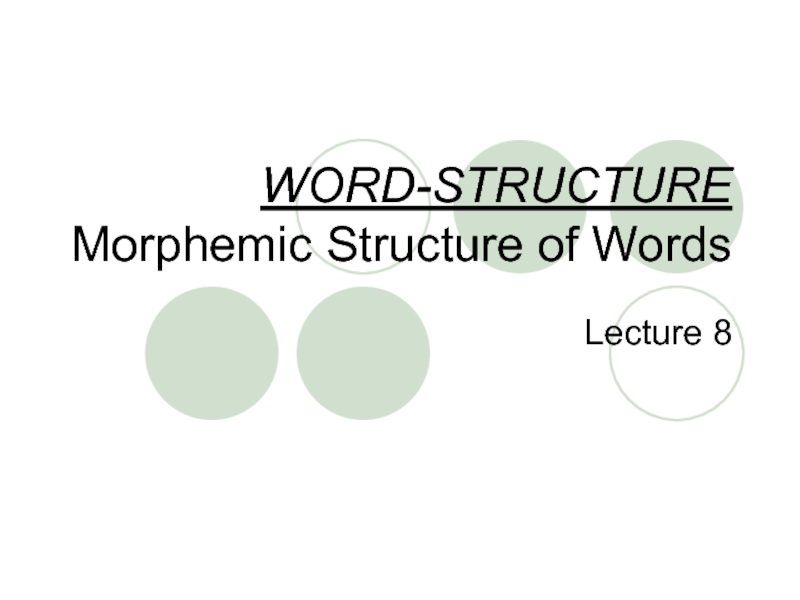
Слайд 21. Word-Structure and Morphemes
Morphe – ‘form’ + -eme. The Greek suffix
– eme has been adopted by linguists to denote the smallest unit (phoneme, sememe, lexeme)
Word-structure is internal organization of words.
The morpheme is the smallest indivisible two-facet language unit.
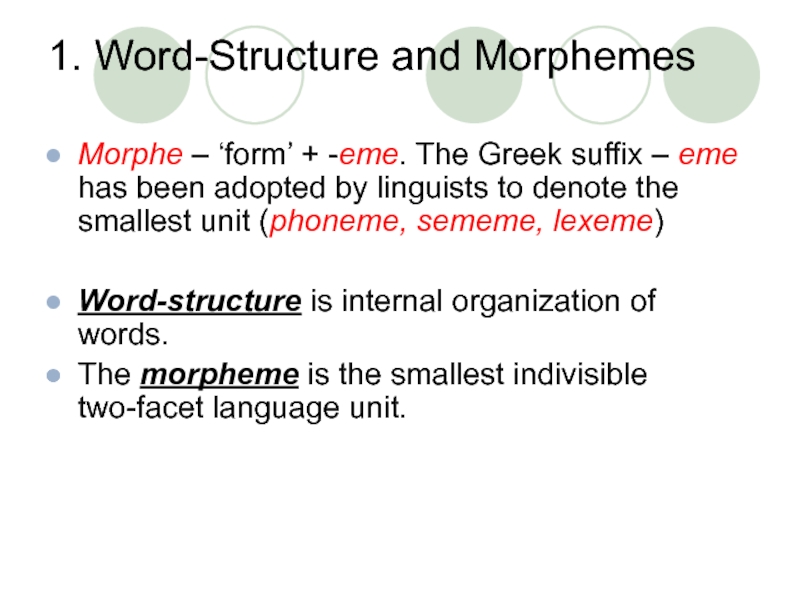
Слайд 3MORPHEMES
Morphemes cannot be segmented into smaller units without losing their constitutive
essence (two-facetedness) – association of a certain meaning with a certain sound-pattern.
Morphemes occur in speech only as constituent parts of words but not independently.
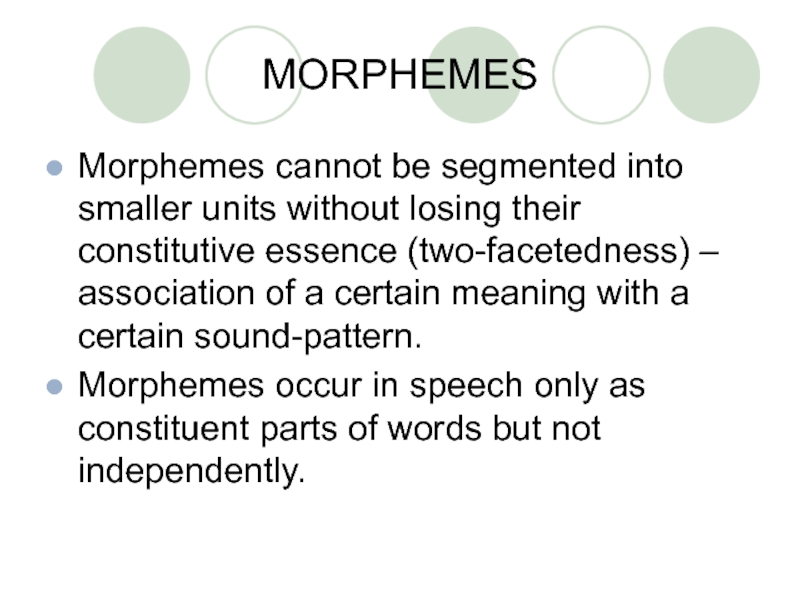
Слайд 4SEGMENTATION OF WORDS
INTO MORPHEMES
Boiler = boil- + er;
Driller = drill-
+ er ;
recurrence of the morpheme -er in these and other similar words and of the morphemes boil- and drill- in
to boil, a boil, boiling and
to drill, a drill, drilling, a drill-press, etc.
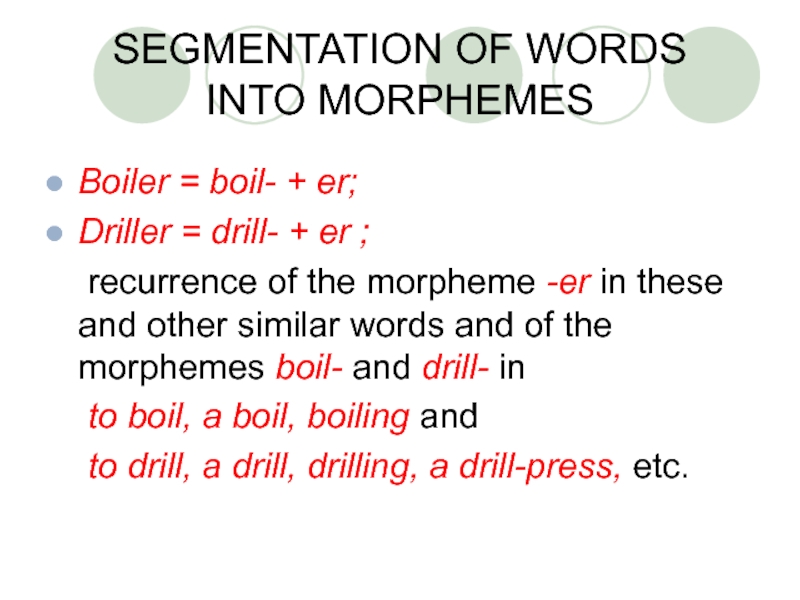
Слайд 5SEGMENTATION OF WORDS
INTO MORPHEMES
flower-pot = flower- + -pot;
shoe-lace = shoe-
+ -lace;
Like a word a morpheme is a two-facet language unit, an association of a certain meaning with a certain sound-pattern.
Unlike a word a morpheme is not an autonomous unit and can occur in speech only as a constituent part of the word.
Lace [l], [ei] ,[s] — without meaning.
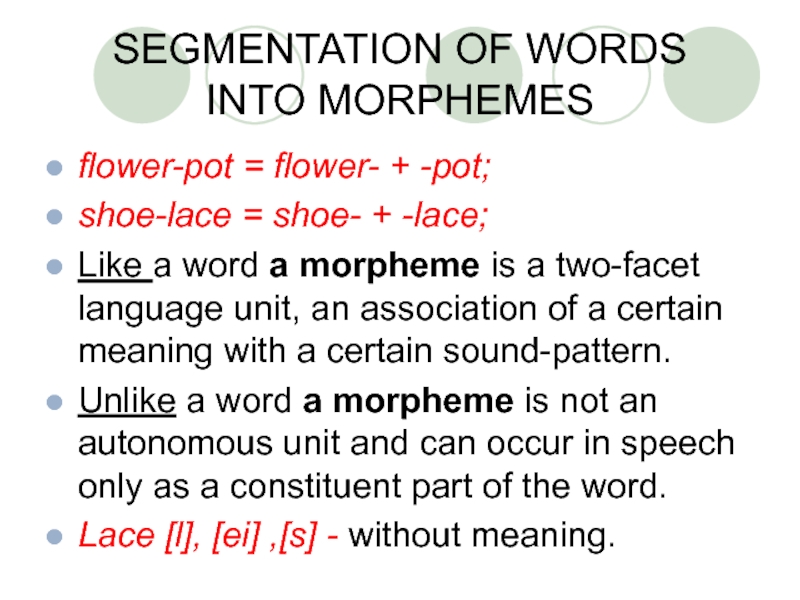
Слайд 6Word-cluster
please pleasing pleasure pleasant
[pli:z] [pli:z] [pleʒ] [plez]
All the representations of the given morpheme that manifest alteration are called allomorphs of that morpheme or morpheme variants.
Thus, [pli:z], [plez] and [рlеʒ] are allomorphs of оnе and the same morpheme.
![Morphemic Structure of Words Word-cluster please pleasing pleasure pleasant [pli:z] [pli:z] Word-cluster please pleasing pleasure pleasant [pli:z]](https://thepresentation.ru/img/tmb/5/464272/1cba0a55ad15a9af6716368ccd8273bb-800x.jpg)
Слайд 7The root-morphemes
in the word-clusters
Duke [dju:k], ducal [‘dju:kl],
duchess [‘d˄tʃiƨ], duchy
[‘d˄tʃi]
or
Poor [puə] , poverty [‘povəti] —
are the allomorphs of one morpheme
![Morphemic Structure of Words The root-morphemes in the word-clustersDuke [dju:k], ducal ['dju:kl], duchess [‘d˄tʃiƨ], duchy The root-morphemes
in the word-clusters Duke [dju:k], ducal ['dju:kl], duchess [‘d˄tʃiƨ], duchy [‘d˄tʃi] or Poor](https://thepresentation.ru/img/tmb/5/464272/fa6410c66ad1e39ef95b89eb4db1e019-800x.jpg)
Слайд 82.1. Semantic Classification of Morphemes
Root-morphemes (radicals) — the lexical nucleus of
words, which has an individual lexical meaning shared by no other morpheme of the language:
Helpless, handy, rewrite, hopeful, disorder
Help- hand- -write hope- -order
The root-morpheme is isolated as the morpheme common to a set of words making up a word-cluster:
work- in to work, worker, working or
theor- in theory, theorist, theoretical, etc.
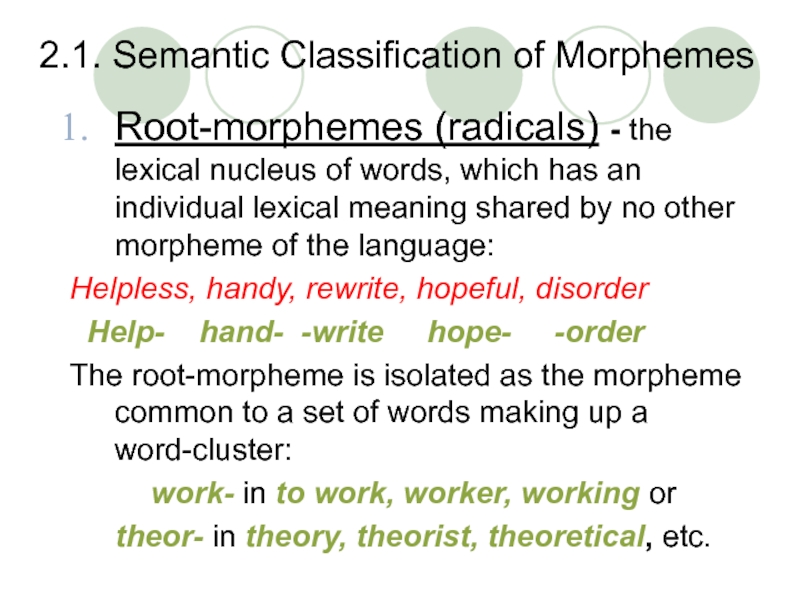
Слайд 9Non-root morphemes
Non-root morphemes include inflectional morphemes (inflections) and affixational morphemes (affixes).
Inflections carry only grammatical meaning.
Lexicology is concerned only with affixational morphemes.
A prefix: understand – mis-understand, correct – in-correct).
A suffix: (-en, -y, -less in heart-en heart-y, heart-less).
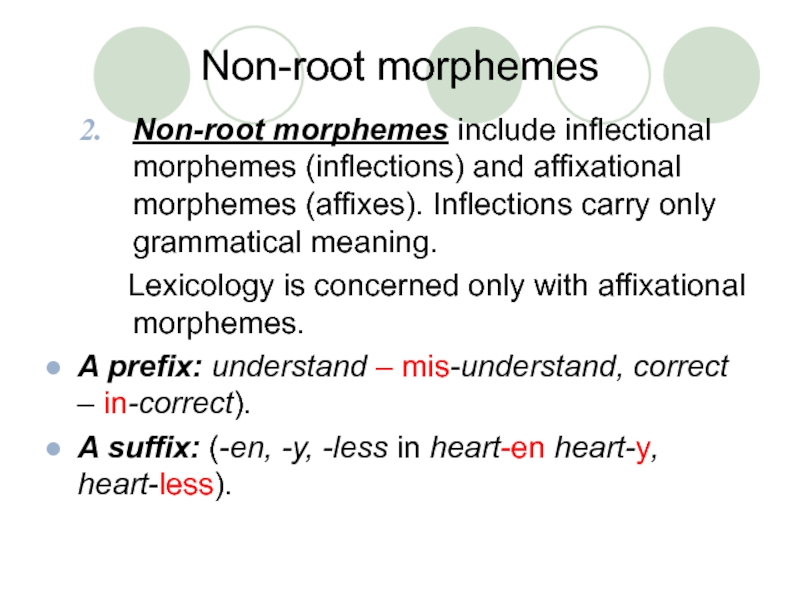
Слайд 102.2. Structural Classification of Morphemes
A free morpheme — one that coincides
with the stem or a word-form. Many root-morphemes are free morphemes, for example, use − of the noun useless is a free morpheme because it coincides with one of the forms of the noun use.
A bound morpheme — a morpheme that must be attached to another element. It occurs only as a constituent part of a word. Affixes are bound morphemes for they always make part of a word, for example:-ness, -ship in the words kind-ness, friend-ship; un-, dis- in the words un-tidy, dis-like.
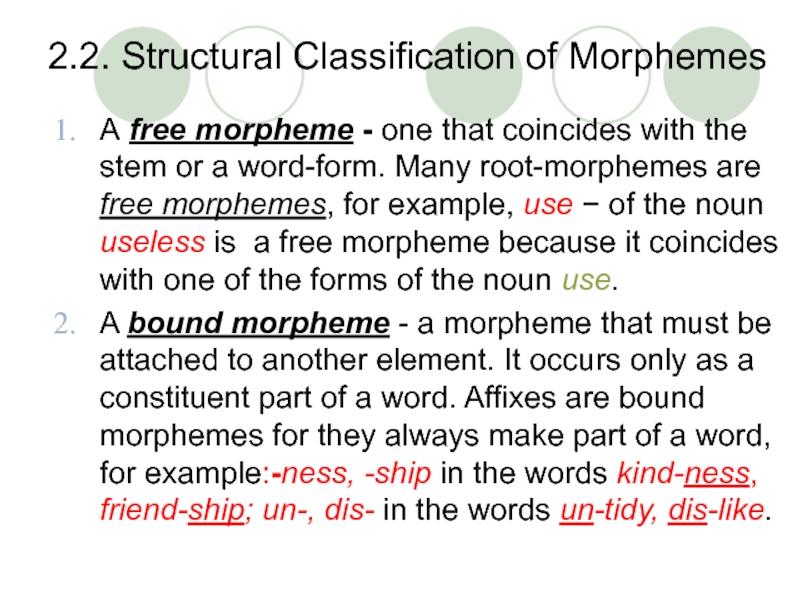
Слайд 11All unique roots and pseudo-roots are-bound morphemes.
Such are the root-morphemes
theor- in theory, theoretical, etc.,
barbar-in barbarism, barbarian, etc.,
-ceive in conceive, perceive, etc.
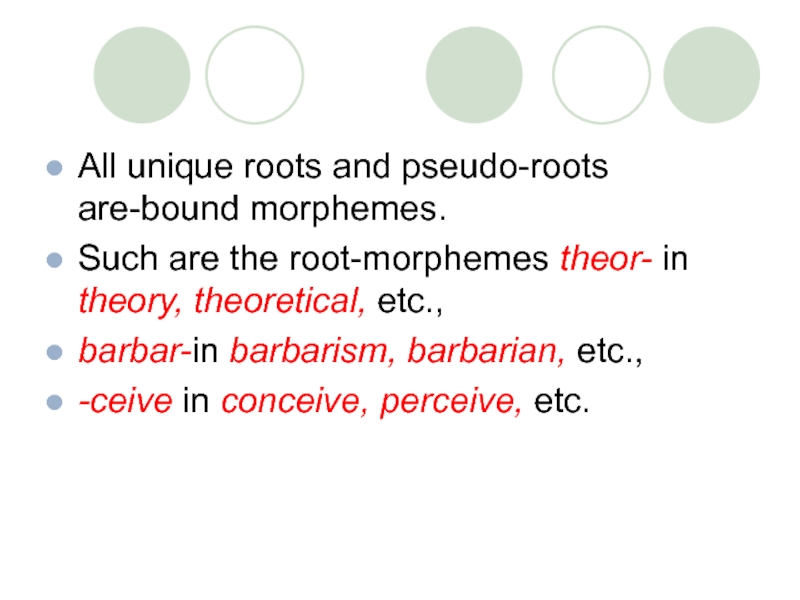
Слайд 12Semi-bound (semi-free) morphemes -morphemes that can function in a morphemic sequence
both as an affix and as a free morpheme: the morpheme well and half can occur as free morphemes: sing well, half a month.
They can also occur as bound morphemes in words like well-known, half-eaten, half-done.
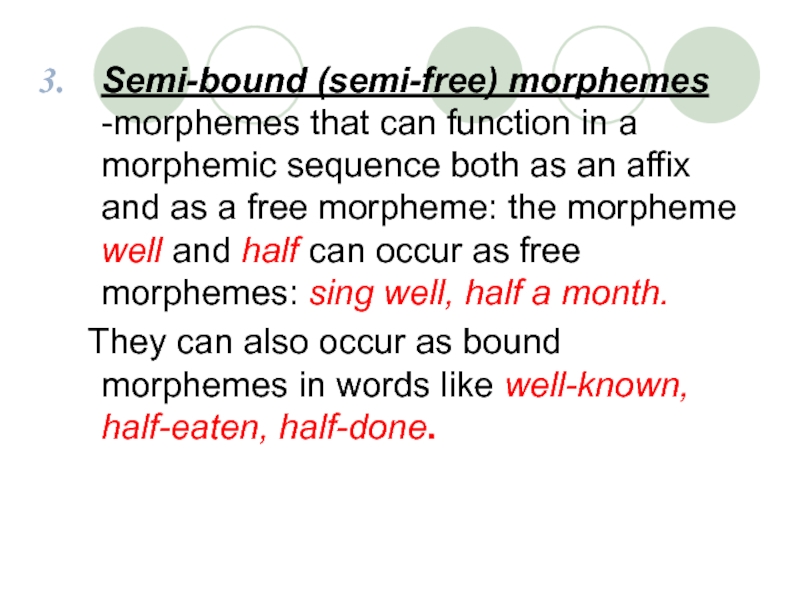
Слайд 13The relationship between the two classifications of morphemes
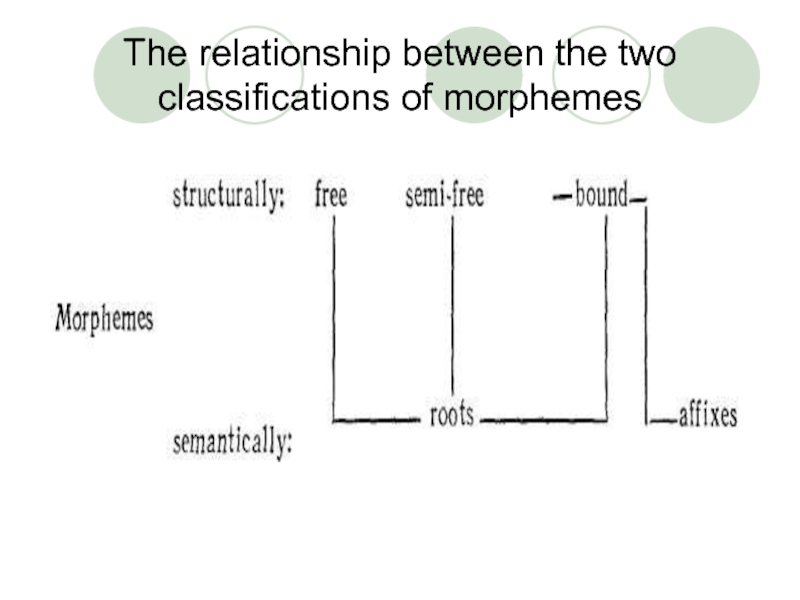
Слайд 14Word-structure
on the morphemic level:
1st Group — Combining forms are morphemes
borrowed namely from Greek or Latin in which they exist as free forms. They are considered to be bound roots: tele-phone consists of two bound roots.
Phonoscope = ‘sound’ + ‘seeing’;
Microscope = ‘smallness’ + ‘seeing’;
Telegraph = ‘far’ + ‘writing’;
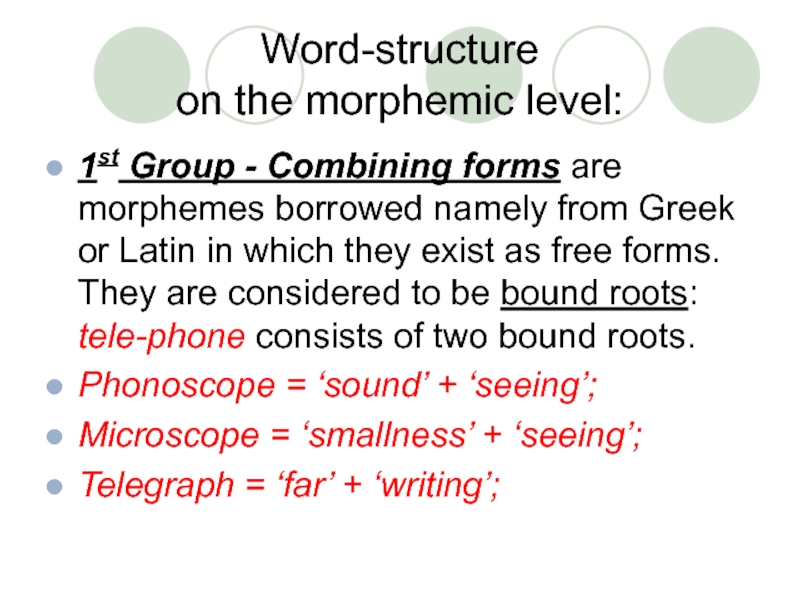
Слайд 15The 2nd Group embraces morphemes occupying a kind of intermediate position,
morphemes that are changing their class membership.
Root morpheme man – in postman, fisherman, gentleman, etc. in comparison with man-made, man-servant.
-man = -er; in cabman, chairman, tradesman
Not a male adult But agent!
* She is an Englishman
*All women are tradesmen.
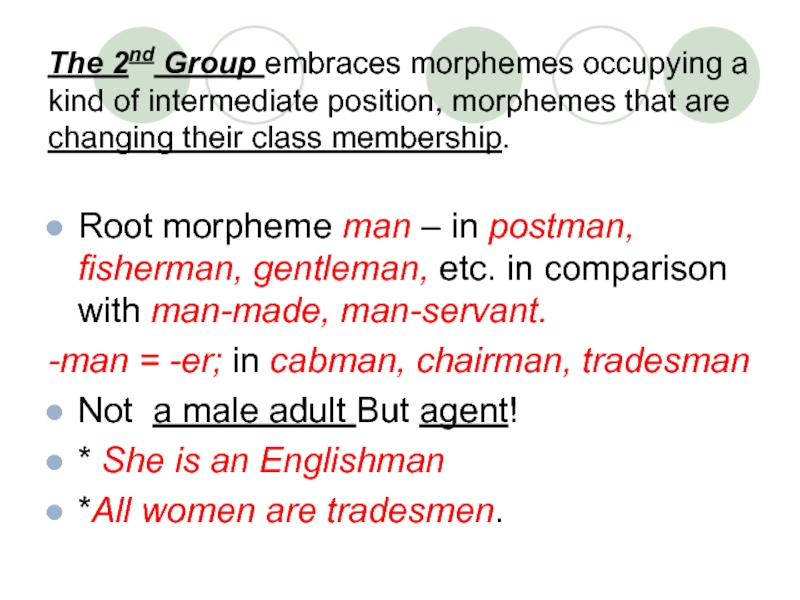
Слайд 163. TYPES OF MEANING IN MORPHEMES
In morphemes can be singled out
different types of meaning depending on the semantic class they belong to.
Root-morphemes have lexical, differential and distributional types of meaning.
Affixational morphemes have lexical, part of-speech, differential and distributional types of meaning.
Both root-morphemes and affixational morphemes are devoid of grammatical meaning.
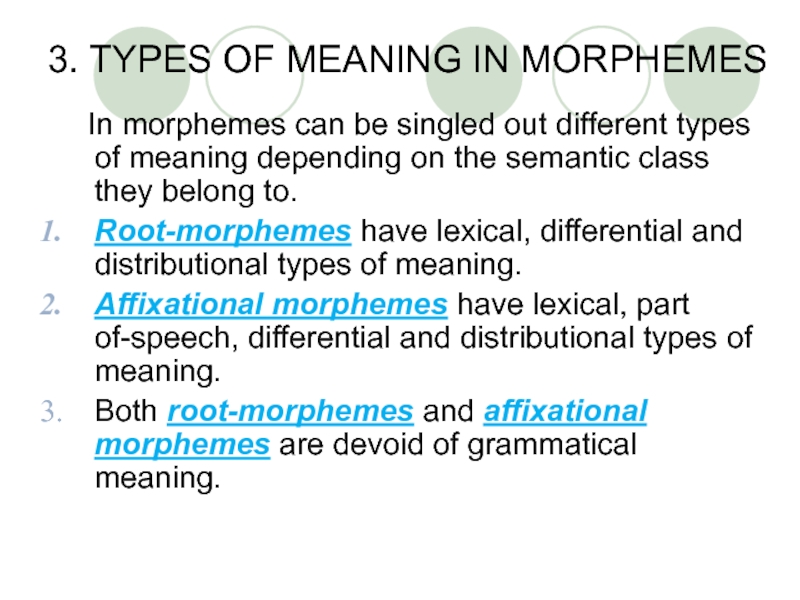
Слайд 173.1. LEXICAL MEANING
Root-morphemes have an individual lexical meaning shared by no
other morphemes in the language: light, deaf, deep, etc.
Affixational morphemes have a more generalizing character of lexical meaning: the suffix –en carries the meaning “the change of a quality”, e.g. to lighten – to become lighter, to deafen – to make somebody deaf.
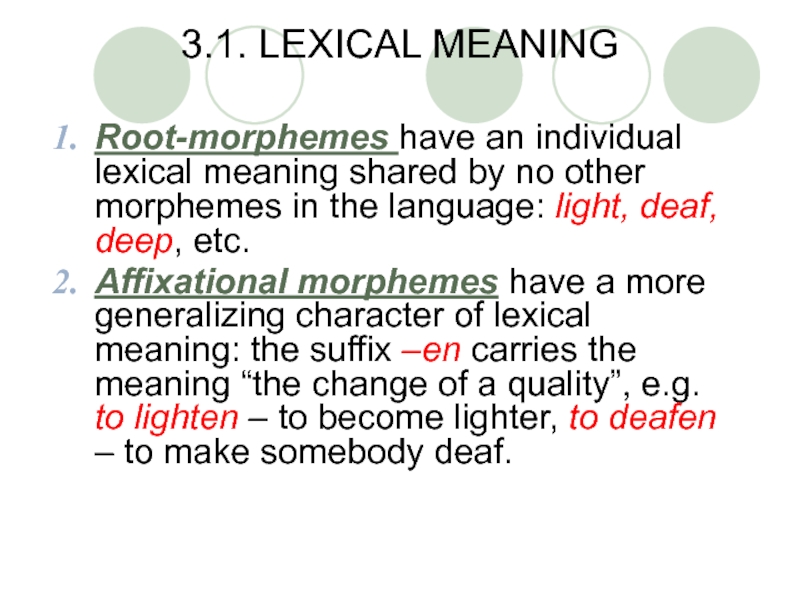
Слайд 18Morphemes may be also analyzed into denotational and connotational components:
The
connotational component of meaning may be found in affixational morphemes: -ette (kitchenette); -ie (dearie, girlie); -ling (duckling) bear a heavy emotive charge.
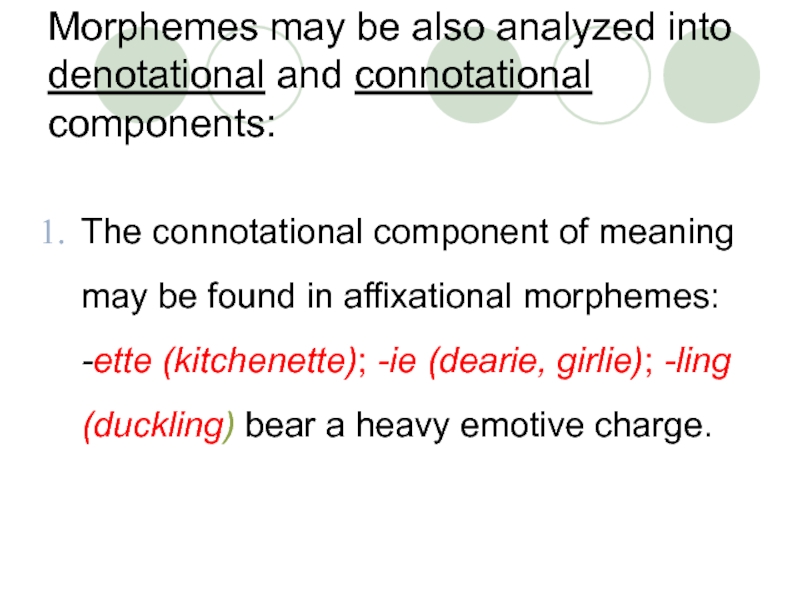
Слайд 19The affixational morphemes with the same denotational meaning sometimes differ only
in connotation: the morphemes –ly, –like, -ish in the words womanly, womanlike, womanish have the same denotational meaning of similarity but differ in the connotational component (женственный – женский – бабий).
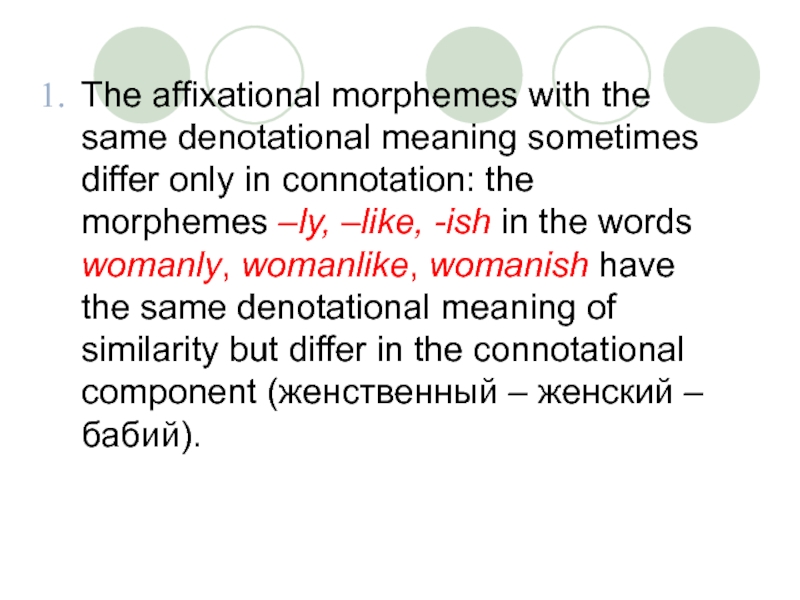
Слайд 20Stylistic reference may be found in morphemes of different types: the
affixational morphemes –
-ine (chlorine), -oid (rhomboid)
are bookish.
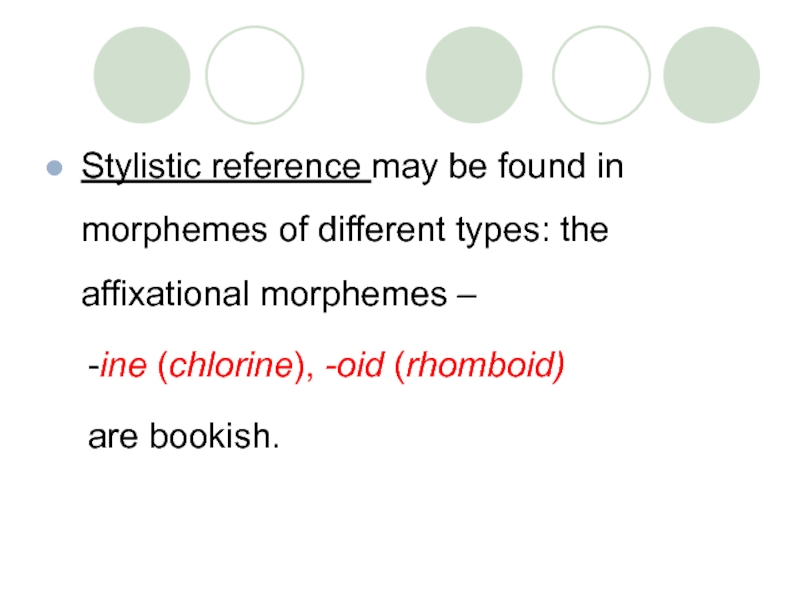
Слайд 213.2. DIFFERENTIAL MEANING
Differential meaning is the semantic component that serves to
distinguish one word from all others containing identical morphemes. In words consisting of two or more morphemes, one of the constituent morphemes always has differential meaning: in the word forehead the morpheme – head serves to distinguish the word from other words containing the morpheme fore-: forefoot, forepart, foreground.
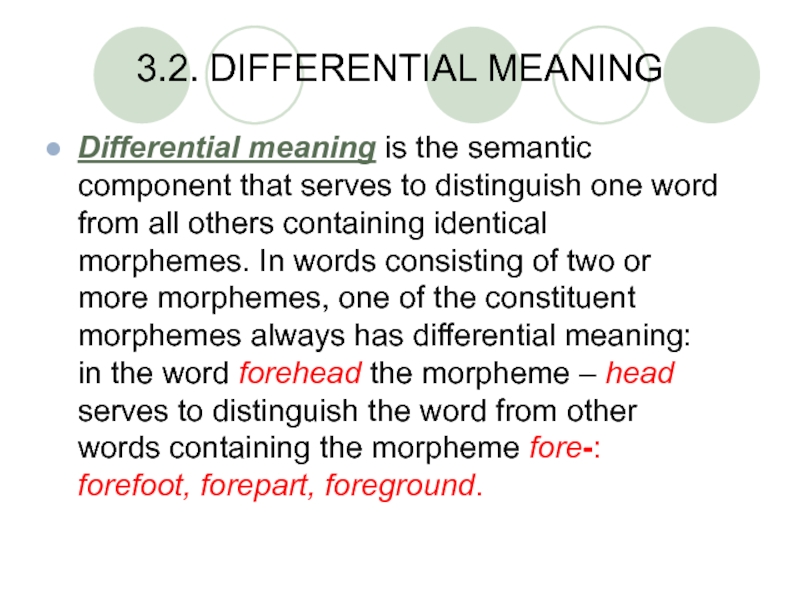
Слайд 223.2. DISTRIBUTIONAL MEANING
Distributional meaning is the meaning of the order and
arrangement of morphemes making up the word.
It is found in all words containing more than one morpheme: the word teacher is composed of two morphemes teach- and –er both of which possess the denotational meaning ‘to help students to learn something’ and ‘the doer of the action’.
A different arrangement of the same morphemes *erteach would make the word meaningless.
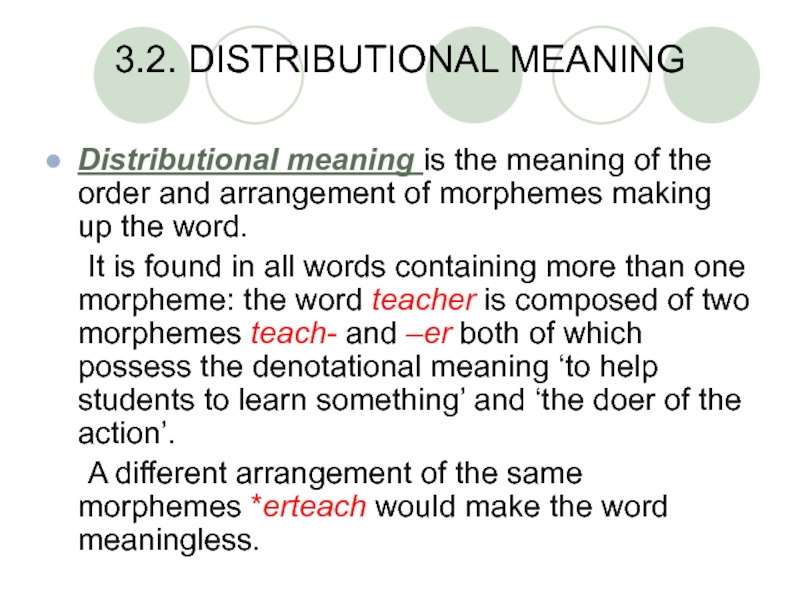
Слайд 233.4. PART-OF-SPEECH MEANING
Part-of-speech meaning is the indicative of the part of
speech to which a derivational word belongs: the affixational morpheme – ness (darkness) is used to form nouns, while the affixational morpheme –less (careless) forms adjectives.
Sometimes the part-of-speech meaning of morphemes predominates: the morpheme –ice in the word justice serves principally to transfer the part-of-speech meaning of the morpheme just- into another class and namely that of the noun.
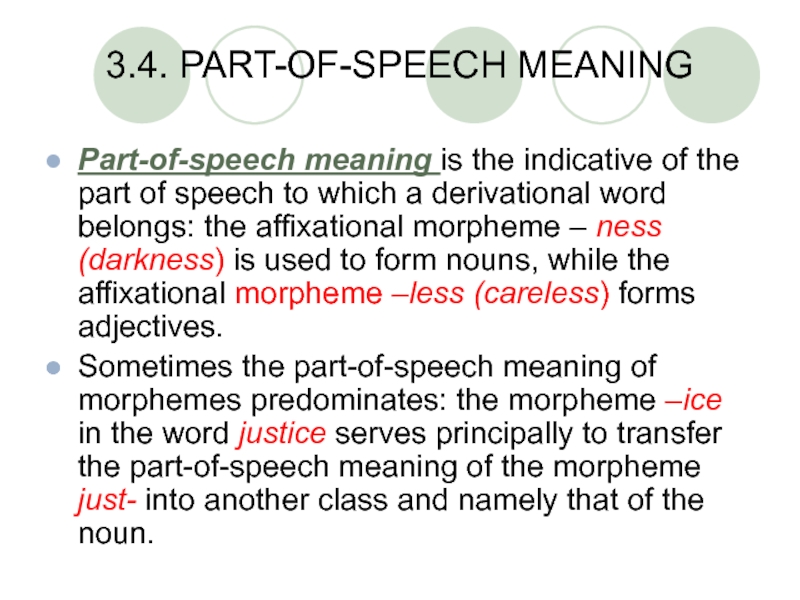
Слайд 244. MORPHEMIC TYPES OF WORDS
According to the number of morphemes words
are classified into monomorphic (root-words) and polymorphic words.
Monomorphic or root-words consist of only one root-morpheme: small, dog, make, put, doll, pen, ect.
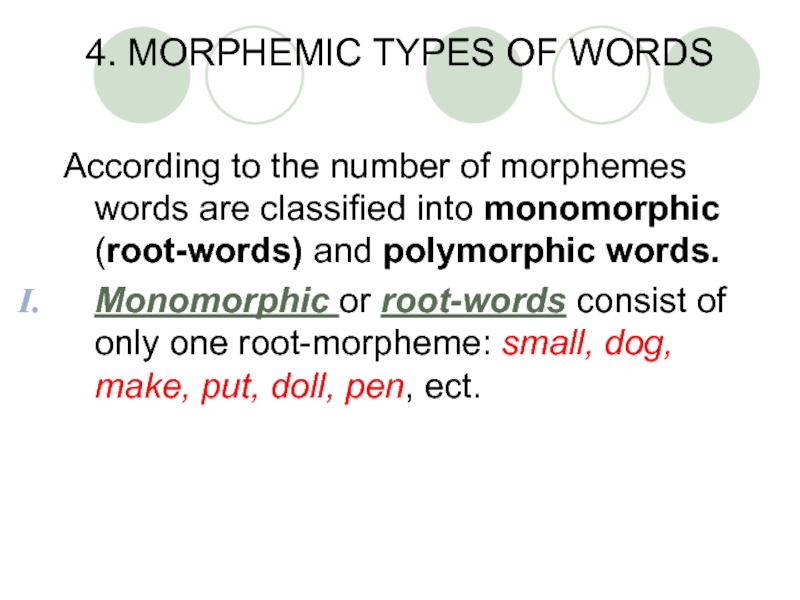
Слайд 25Polymorphic words according to the number of root-morphemes are classified into:
Monoradical words (having one-root morpheme) fall into three subtypes:
radical-suffixal words, i.e. words consisting of one root-morpheme and two or more suffixal morphemes, for example, respectable, respectability;
radical-prefixal words, i.e. words consisting of one root-morpheme and a prefixal morpheme, for example, overcome, unbutton;
prefixo-radical-suffixal words, i.e. words which consist of one root, prefixal and suffixal morphemes (e.g. unforgettable, misinterpretation).
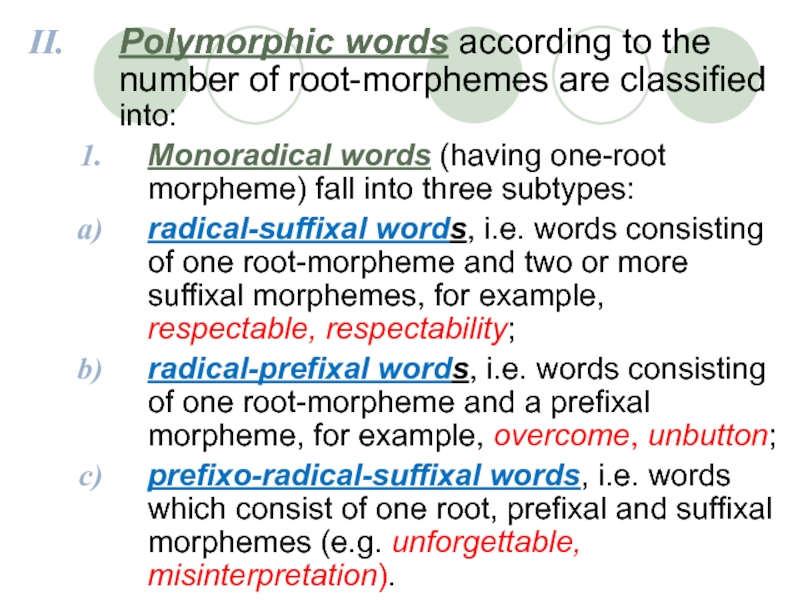
Слайд 26Polyradical words (having words consisting of two or more roots) fall
into two subtypes:
polyradical words which consist of two or more roots with no affixational morpheme, for example, pen-friend, copybook;
polyradical words which contain at least two roots and one or more affixational morpheme, for instance, safety-pin, light-mindedness, pen-holder.
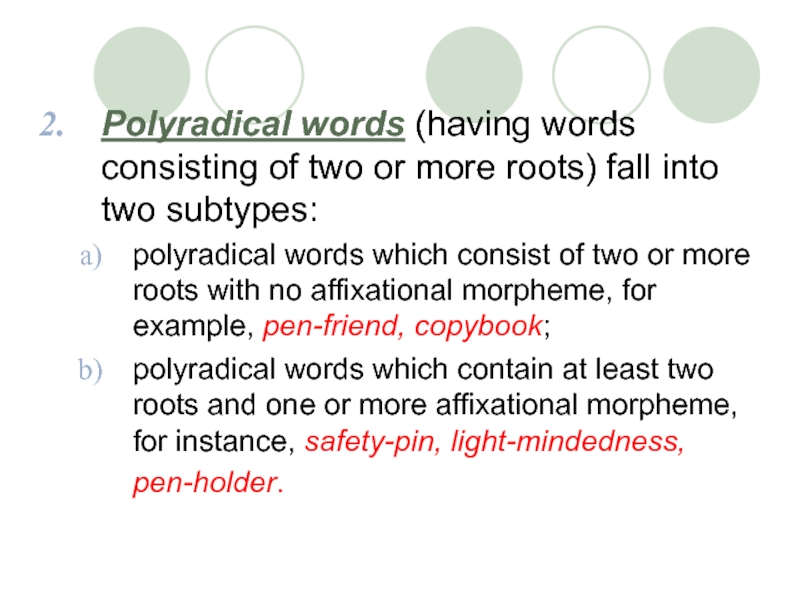
Слайд 275. TYPES OF WORD-SEGMENTABILITY
Word-segmentability is the division of words into
morphemes.
Three types of morphemic segmentability of words are distinguished:
complete,
conditional,
defective.
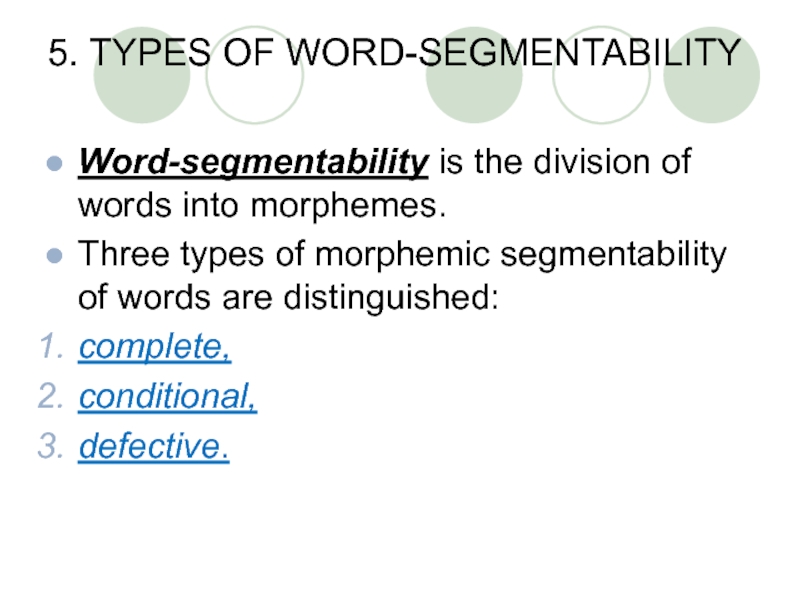
Слайд 285.1. COMPLETE SEGMENTABILITY
Complete segmentability
is characteristic of words, the morphemic structure
of which is transparent enough, as their individual morphemes clearly stand out within the word and can be easily isolated.
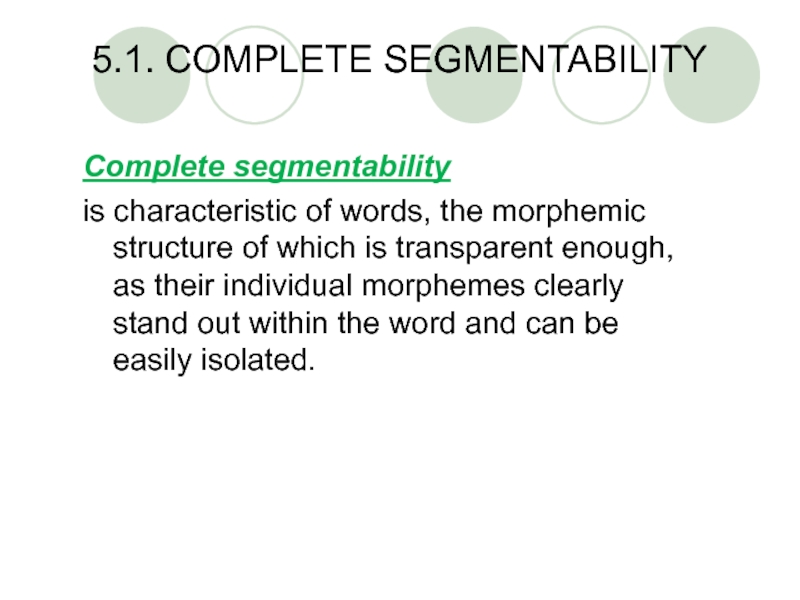
Слайд 29The morphemes making up words of complete segmentability are called morpheme
proper or full morphemes
The transparent morphemic structure of the segmentable words careless, stressful is conditioned by the fact that their constituent morpheme recur with the same meaning in other words: thoughtful, powerful.
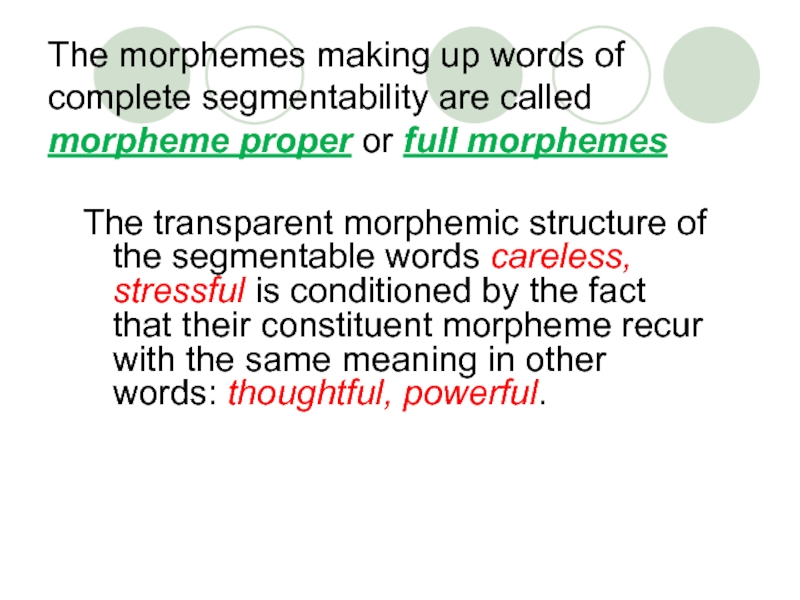
Слайд 305.2. CONDITIONAL SEGMENTSBILITY
Conditional segmentability characterizes words whose segmentation into the constituent
morphemes is doubtful for semantic reasons.
In the words retain, detain or deceive the sound-cluster – [ri-], [di-] seem to be singled out easily due to their recurrence in a number of words (cf. rewrite, reorganize, decode, deorganize).
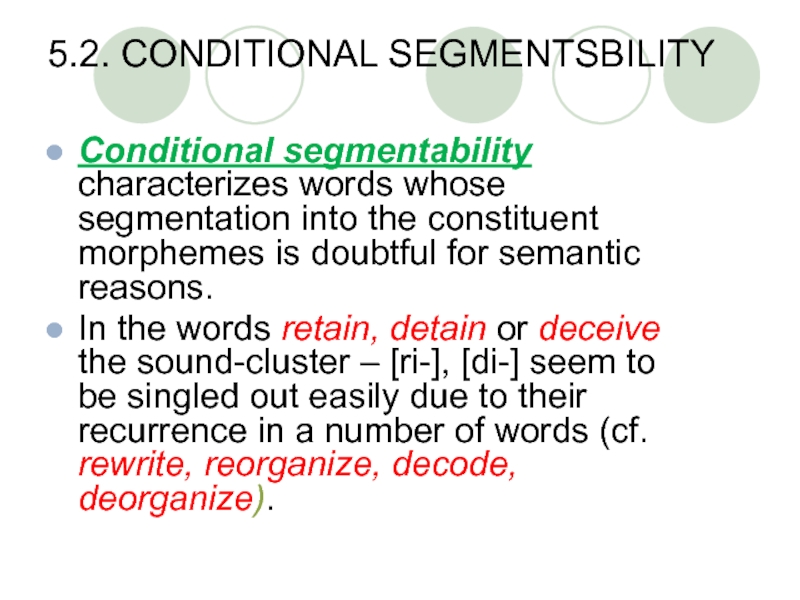
Слайд 31Neither [ri-], [di-] nor [-tain], [si:v] possess any lexical or part-of-speech
meaning of their own.
They have differential and distributional meanings: the [ri-] distinguishes retain from detain and the [-tein] distinguishes retain from receive, whereas their order and arrangement point to the status of the re-, de- as different from that of the –tain and –ceive within the structure of the words.
![Morphemic Structure of Words Neither [ri-], [di-] nor [-tain], [si:v] possess any lexical or part-of-speech Neither [ri-], [di-] nor [-tain], [si:v] possess any lexical or part-of-speech meaning of their own.](https://thepresentation.ru/img/tmb/5/464272/167acbe9fbb5bd366cfd39e2644d46bb-800x.jpg)
Слайд 32The morphemes making up words of conditional segmentability do not rise
to the status of full morphemes for semantic reason and that is why are called pseudo-morphemes or
quasi-morphemes.
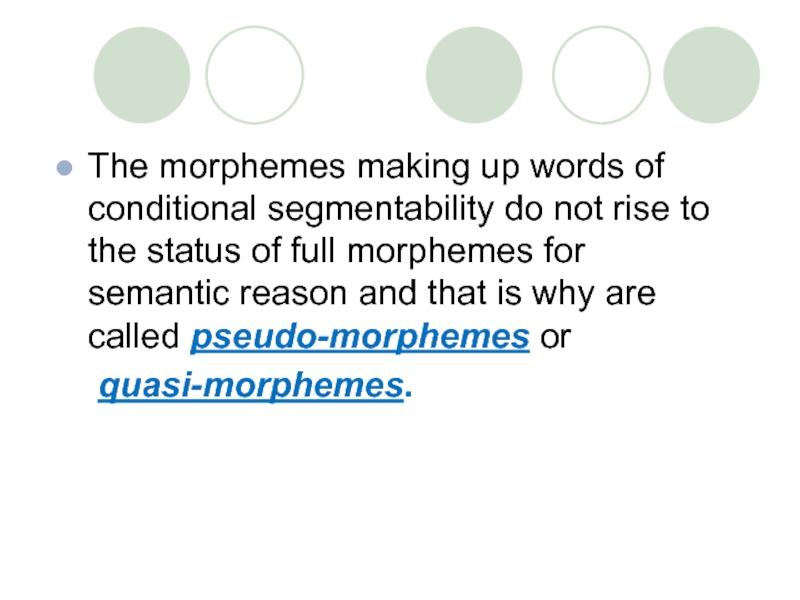
Слайд 335.3. DEFECTIVE SEGMENTABILITY
Defective segmentability is the property of words whose component
morphemes seldom or never recur in other words.
One of the component morphemes of these words is a unique morpheme, which is isolated and understood as meaningful because the constituent morphemes display a more or less clear denotational meaning.
In streamlet, ringlet, leaflet the morpheme –let has diminutive meaning.
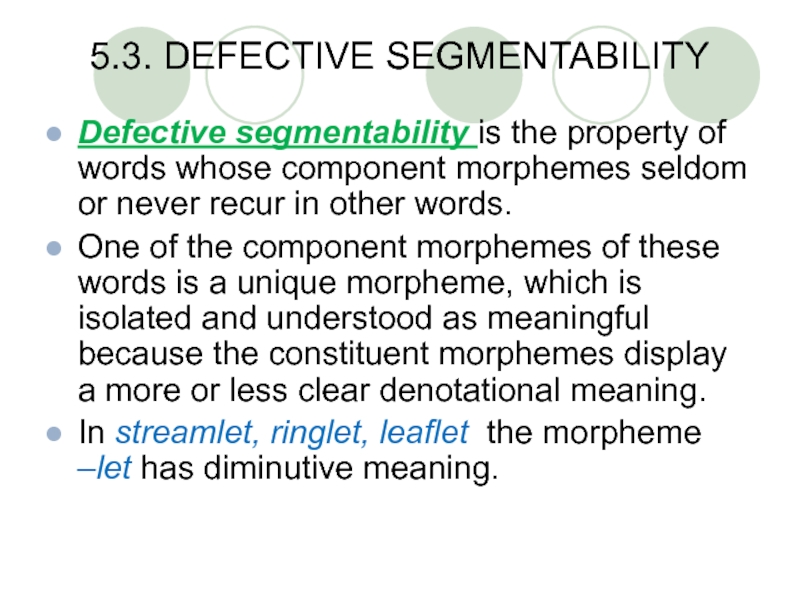
Слайд 34In the word hamlet the morpheme -let has the meaning of
diminutiveness. This morpheme occurs in the words ringlet, leaflet, streamlet.
The sound-cluster [hæm-] does not recur in any other English word.
The morpheme ham- carries a differential and distributional meaning as it distinguishes hamlet from streamlet, ringlet.
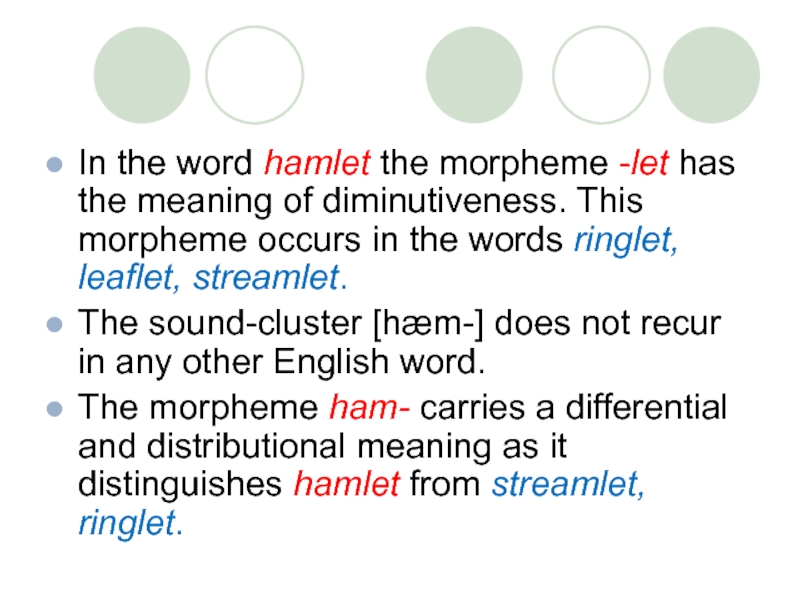
Слайд 35comparison with words
locket, lionet, cellaret, etc. leads one to the
isolation of the morpheme -et having a diminutive meaning, the more so that the morphemes lock-, lion-, cellar-, etc. recur in other words: (cf. lock, locky; lion, lioness; cellar, cellarage).
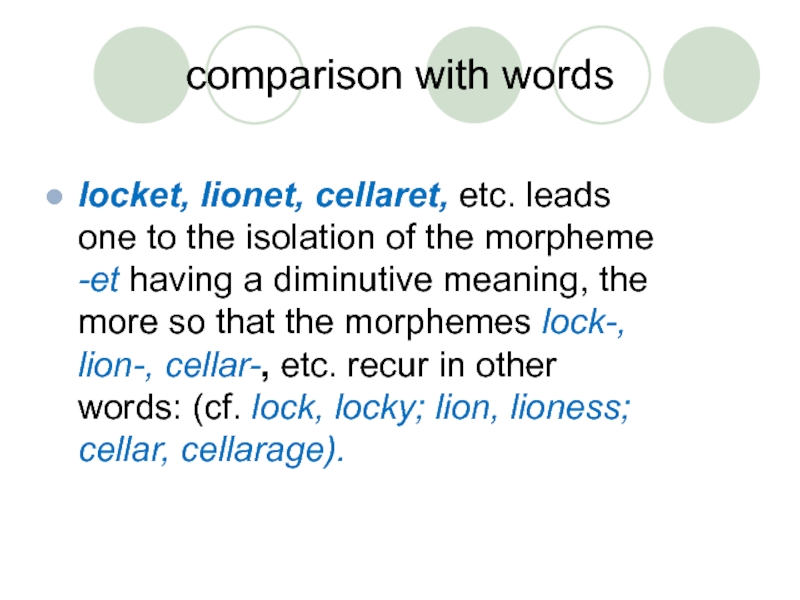
Слайд 36The isolation of the morpheme -et leaves in the word pocket
the sound-cluster [роk] that does not occur in any other word of Modern English.
The morpheme [роk] clearly carries a differential and distributional meaning as it distinguishes pocket from the words mentioned above and thus must be qualified as a unique morpheme.
![Morphemic Structure of Words The isolation of the morpheme -et leaves in the word pocket The isolation of the morpheme -et leaves in the word pocket the sound-cluster [роk] that does not](https://thepresentation.ru/img/tmb/5/464272/b502e851df1674962702a75c019e4bb7-800x.jpg)
Слайд 37The morphemic analysis of words like
cranberry, gooseberry, strawberry shows that
they also possess defective morphemic segmentability: the morphemes cran-, goose-, straw- are unique morphemes.
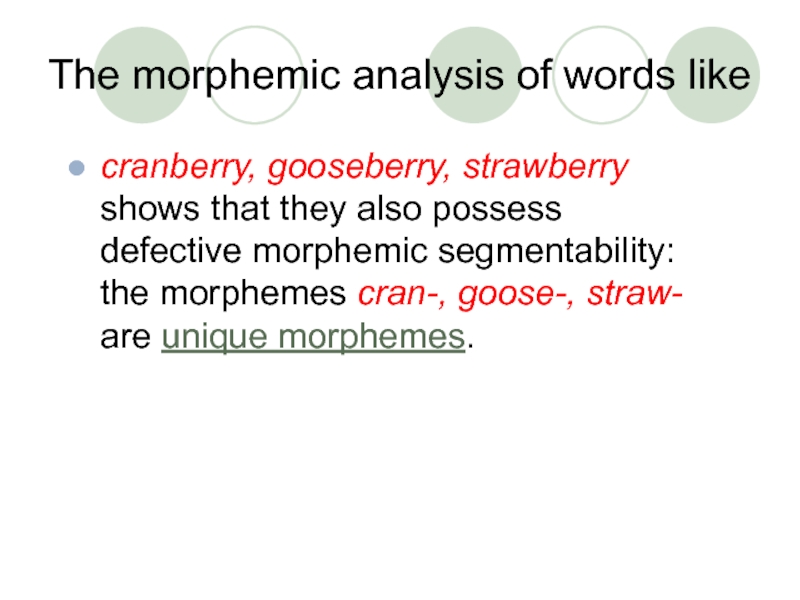
Слайд 38on the level of morphemic analysis
the linguist has to operate
with two types of elementary units, namely full morphemes and pseudo-(quasi-)morphemes.
A considerable percentage of words of conditional and defective segmentability signals a relatively complex character of the morphological system of the language, reveals the existence of various heterogeneous layers in its vocabulary.
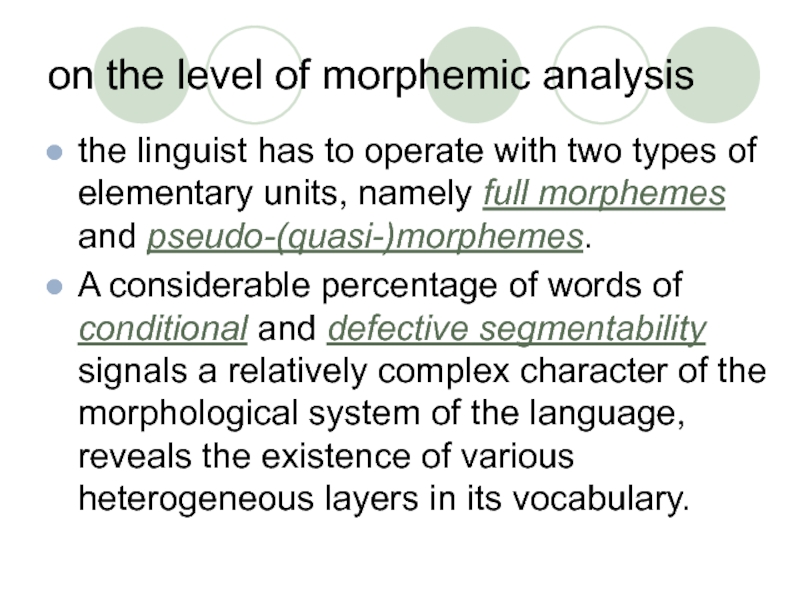
Слайд 397. PROCEDURE OF MORPHEMIC ANALYSIS
The procedure of segmenting words into the
constituent morphemes is known as the method of Immediate and Ultimate Constituents (any of two meaningful parts forming a larger linguistic unit. L. Bloomfield).
It is based on a binary principle, i.e. each stage of the procedure involves two components the word immediately breaks into.
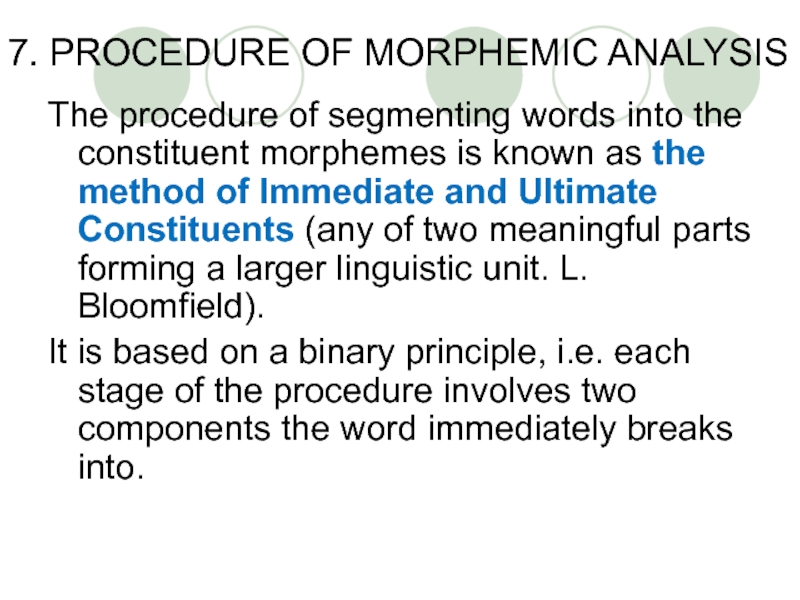
Слайд 40At each stage these two components are referred to as the
Immediate constituents (ICs). Each IC at the next stage of analysis is broken into smaller meaningful elements.
The analysis is completed when constituents are incapable of further division, i.e. morphemes.
These morphemes are referred to as the Ultimate Constituents (UCs).
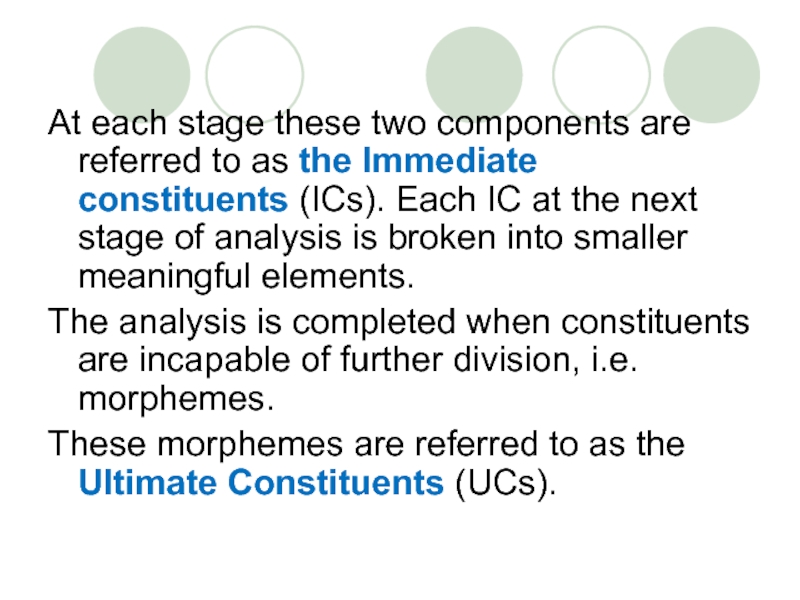
Слайд 41The noun friendliness is first segmented into the ICs:
friendly- (recurring
in the adjectives friendly and friendly-looking).
–ness (found in a countless number of nouns): happiness, darkness.
The IC –ness is at the same time an UC of the noun, as it cannot be broken into any smaller elements possessing both sound-form and meaning.
The IC friendly- is next broken into the ICs
friend- (recurring in friendship, unfriendly) and
–ly (recurring in wifely, brotherly).
The ICs friend- and –ly are both UCs of the word under analysis.
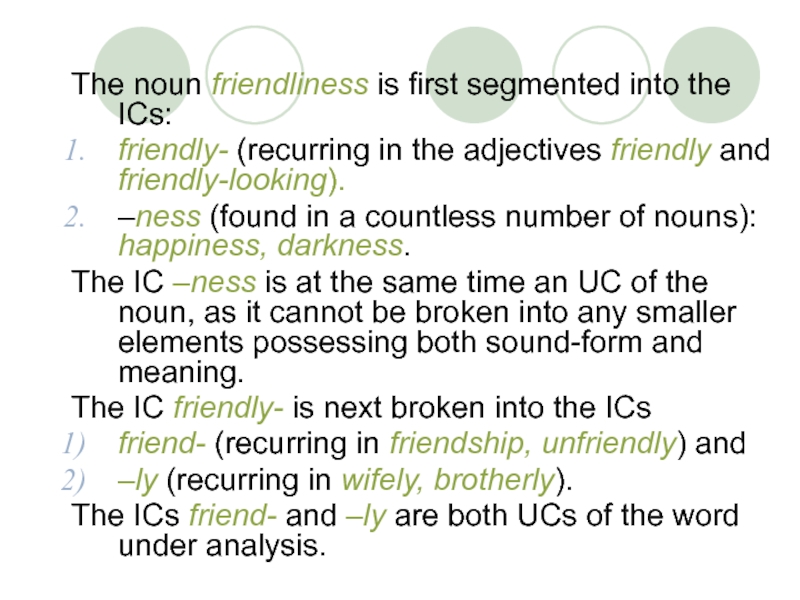
Слайд 42The procedure of segmenting a word into its Ultimate Constituent morphemes
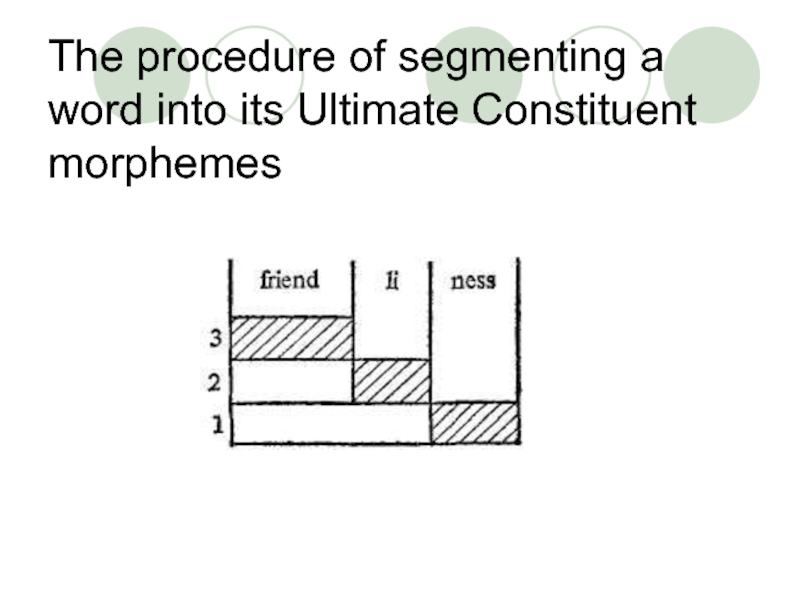
Слайд 438. PRINCIPLES OF WORD-SEGMENTATION
According to the affix principle the segmentation of
the word into its constituent morphemes is based on the identification of an affixational morpheme within a set of words, for example, the identification of the morphemes –less leads to the segmentation of words like thoughtless, careless, merciless into the suffixational morpheme –less and the root-morphemes thought-, care-, merci- within a word-cluster.
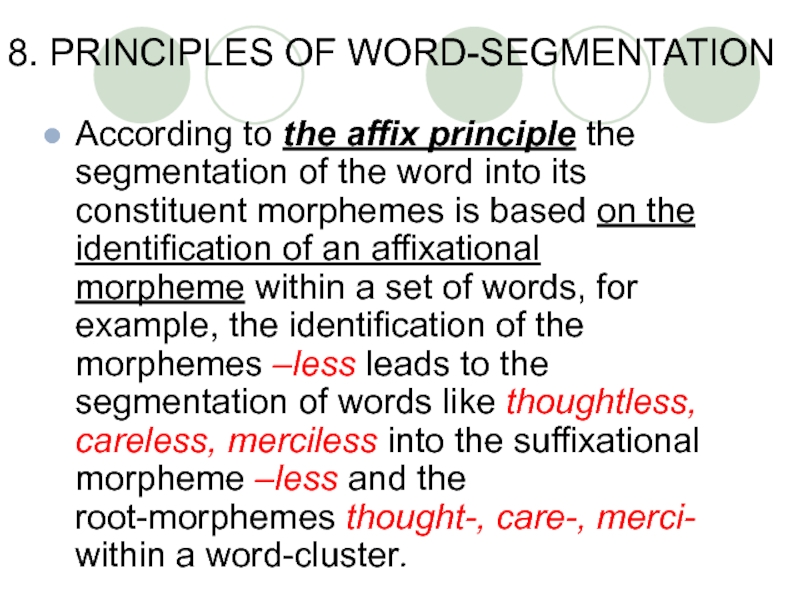
Слайд 44According to the root principle the identification of the root-morpheme agree-
in the words agreeable, agreement, disagree makes it possible to split these words into the root agree- and the affixational morphemes -able, -ment, dis-.
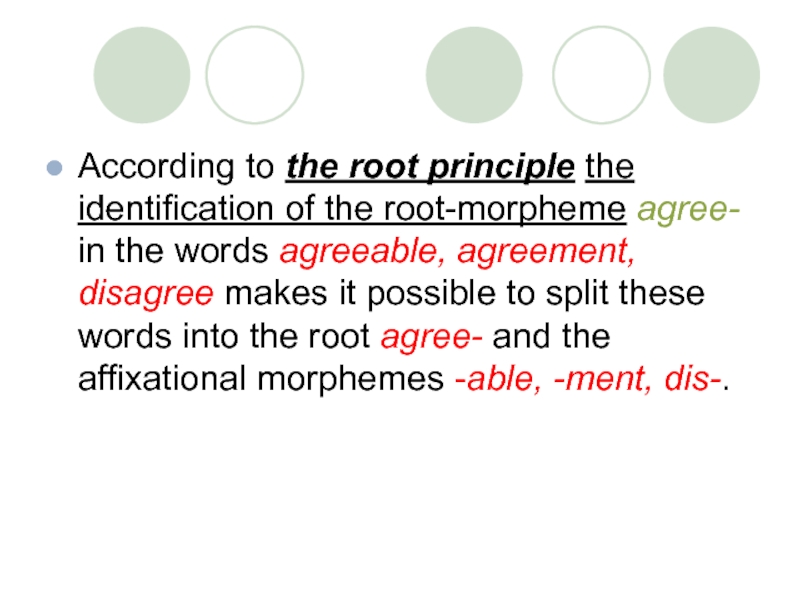
Слайд 45Summary and Conclusions:
There are two levels of approach to the study
of word-structure: the level of morphemic analysis and the level of derivational or word-formation analysis.
The basic unit of the morphemic level is the morpheme defined as the smallest indivisible two-facet language unit.
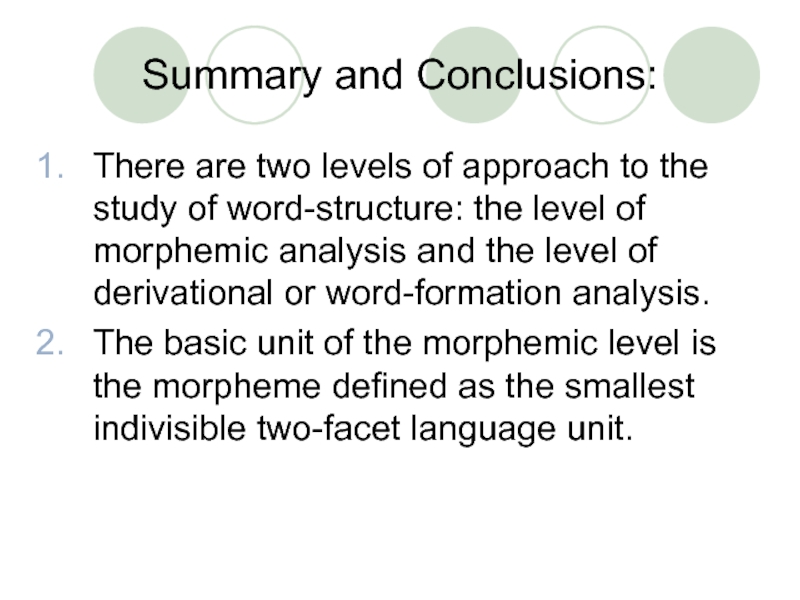
Слайд 46Summary and Conclusions:
Three types of morphemic segmentability of words are distinguished
in linguistic literature: complete, conditional and defective. Words of conditional and defective segmentability are made up of full morphemes and pseudo (quasi) morphemes. The latter do not rise to the status of full morphemes either for semantic reasons or because of their unique distribution.
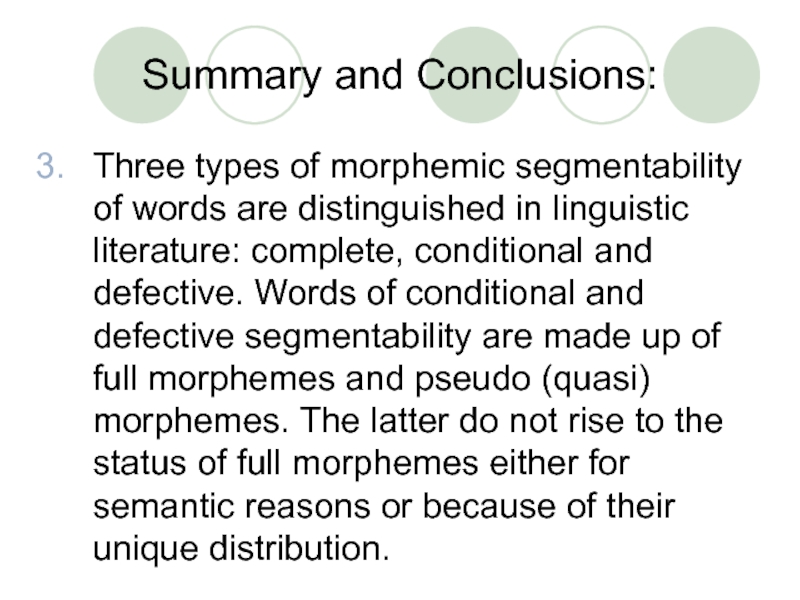
Слайд 47Summary and Conclusions:
Semantically morphemes fall into root-morphemes and affixational morphemes (prefixes
and suffixes); structurally into free, bound and semi-free (semi-bound) morphemes.
The structural types of words at the morphemic level are described in terms of the number and type of their ICs as monomorphic and polymorphic words.
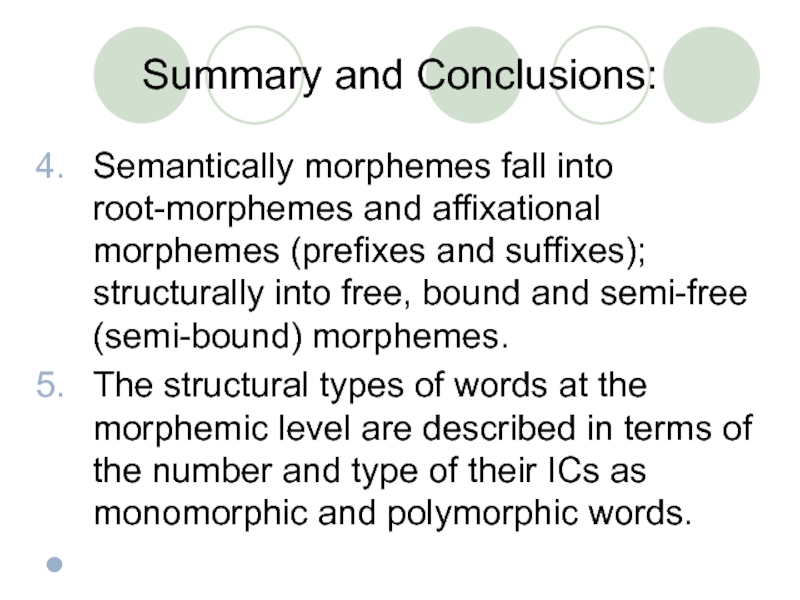
Слайд 48References
Зыкова И.В. Практический курс английской лексикологии. М.: Академия, 2006. – С.
52-56.
Гинзбург Р.З. Лексикология английского языка. М.: Высшая школа, 1979. – С. 89-106.
Антрушина Г.Б., Афанасьева О.В., Морозова Н.Н. Лексикология английского языка. М.: Дрофа, 2006. – С. – 78-128.
